We work with your website designer to improve your ability to be found in Google and other search engines and to look good wherever you may appear online. My Local
Don't wanna be here? Send us removal request.
Text
Press Release Distribution – 10 Benefits

14 Best Press Release Distribution Services
Press releases have become more versatile than ever before especially in today's social marketing scene. They've obviously been around for a long time but apart from the purposes of announcing a new product launch or a company's latest acquisition, press releases also provide huge publicity for businesses as well as SEO benefits. Here are some of the advantages of press release distribution:
HUGE viewership and customer base
Around the world, more than 80 million are reading the news. If just 0.1% of those readers read your press release and bought your product, you'd be benefitting quite a lot. There's a huge pool of potential customers out there, so make the most of it and write a press release that's worth reading. However, don't turn your press release into an advertisement.
Increased visibility and trust
The more people read about you, the more they know you. Before you know it, customers and journalists begin to empathise with you and support your cause which of course, should be good for mankind and not the opposite. The more people that understand your purpose and objectives, the more likely you'll be covered in the media. So, remember to give them something worth publicising in the first place.
Enhanced SEO efforts from Press Release distribution
It's no surprise how people use press releases to maximise their off-page SEO backlinking efforts. Any SEO marketer would tell you the importance of keyword research and anchor backlinks when writing a press release – all for the sake of SEO. The links commonly found on press releases are not there for decorative purposes, but for readers to click so that they can be redirected to your site. That results in increased traffic which is a ranking factor by itself, not to mention the benefit of backlinks.
Managing and fixing your reputation
Not everyone gets good customer reviews and sometimes just because of one unsatisfied customer, your website's reputation on SERPs could become tarnished. Press release distributions can help you manage your reputation, especially if you've been getting negatively blamed for something you did not do. Optimising your press releases and sending them out for SEO purposes can help you gain back the positive reputation you deserve, pushing all your negative reviews to the back of SERPs.
Why it's called "News", not "Olds"
The achievements and advancements of your company are all highlighted in the press release. With the mass syndication of your press release, your company's information will spread like wildfire. Your prospective customers will not only get the most updated news about your brand but at the same time, you can let people know how successful you are.
Become an industry expert
Don't forget, if you're sending out press releases for people to read about you/your company, you/your company must be something worth reading about. As such, you have to be an expert at something and actually educate and share the information that you've become so well-informed about. Doing so increases your viewer's trust and rapport and eventually, if people like and agree with what you talk about, they're more likely to purchase the service or product that you have to offer.
Press Release Distribution is cost-effective
In terms of SEO, press release distribution can be considered one of the more economical choices. Its results are also more observable and measurable than social media marketing. Generally, using press release distribution to increase traffic and maximise SEO efforts is pretty good value for money. It does depend on your line of business but compared with paid advertising it can be very cost-effective.
Spread your brand virally
We're now in the age of Web2.0, whereby everyone is entitled to contribute to a piece of the internet, everyone can be heard. Any press release that's good enough could be shared multiple times through various social platforms. The end result – a chain effect where your news spread across networks that will drive more online users to read and share your news tips, thus more leads and more sales.
Extend the reach of PRs through RSS feeds
Sometimes, users search for their news through RSS (Really Simple Syndication) newsreaders as there are many websites that allow them to subscribe to these news feeds based on their interests. Using press release distribution extends your reach to these audiences, gaining the mindshare of another customer base beyond your current and already existing one.
Permanent Indexation via Press Release Distribution
Your SERP rankings will be enhanced because these press releases will be indexed by top news search engines, meaning your content will be stored inside Google's (or any other search engine's) database for easy accessibility. This makes it extremely easy for consumers, journalists, and other interested parties to find your content should they search for it on Google.
In short, press release distribution is an effective way to be found, increase your traffic and sales while not costing as much as a large-scale advertising campaign. And with so many new facilities and tools available online, it is now easy to manage and distribute your messages to your target audiences – literally anyone can do it.
What are you waiting for? Submit your press release now. It's time to get some serious publicity! Don’t know where to start? Get in touch with us.
About MyLocal
We work with your website designer to improve your ability to be found in Google and other search engines. Also, to look good wherever you may appear online. We specialise in local SEO and most of our work is off-site. But there may need to be some on-site work undertaken by your webmaster to complement what we do. If you would be interested in finding out more, please use the Contact Form on our website.
Did you read about why and how to get into the 3-pack?
if(window.strchfSettings === undefined) window.strchfSettings = {}; window.strchfSettings.stats = {url: "https://mylocal.storychief.io/en/press-release-distribution?id=99284327&type=2",title: "Press Release Distribution - 10 Benefits",id: "2fa00077-23a5-4f07-b556-c811dc12f64f"}; (function(d, s, id) { var js, sjs = d.getElementsByTagName(s)[0]; if (d.getElementById(id)) {window.strchf.update(); return;} js = d.createElement(s); js.id = id; js.src = "https://d37oebn0w9ir6a.cloudfront.net/scripts/v0/strchf.js"; js.async = true; sjs.parentNode.insertBefore(js, sjs); }(document, 'script', 'storychief-jssdk'))
https://mylocal.org.uk/online-credibility/press-release-distribution/
0 notes
Text
How to get into the 3-pack
What is the 3-pack?
The 3-pack is the list of results that appear when someone is searching online for a local business. If you are a local business you need to be in the 3-pack, especially if someone is searching on a smartphone. Why? Because research has shown that a very high percentage of these local searches end up in a purchase decision.
What factors affect how to get into the 3-pack?
Relevance, Prominence and Proximity.
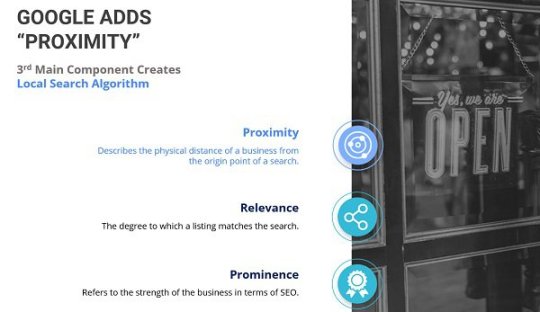
In 2014 Google adds Proximity as the 3rd leg to its search algorithm
In 2014 Google added Proximity as the 3rd leg to its search algorithm, joining the previous two legs which predate “local” searches:
Proximity – Describes the physical distance of a business from the origin point of a search.
Relevance – The degree to which a listing’s website content matches the search inquiry.
Prominence – The strength of the business in terms of its domain authority calculated by traffic, backlinks, etc.
Following that move Google My Business was launched, giving local businesses the opportunity to be found even if they didn’t have a website.
The Proximity Factor
Proximity became the most powerful factor influencing which businesses appeared in the 3-pack. What this means is that if your business is located close to the location of the search, then it is more likely to be in the 3-pack. The further away from the location of the search that your business appears in the 3-pack the better it is for attracting customers. Local SEO is all about trying to push the boundaries of the location for the purpose of appearing in the 3-pack.
Here is a client that has been following our advice for over a year:-

Property letting agency
Here is another client that has been ignoring our advice:-

Restaurant
This grid view plots the results of local searches performed in each of the grids getting further away from the actual location of the business concerned. Where the colour is green the business will be in the 3-pack for that search term. Any other colour and it will not be.
The property letting agency is Belvoir Lettings King’s Lynn and I have their permission to mention their name. I will not mention the name of the Restaurant but will say that it is one of the best in Norwich.
The grids illustrate very clearly that having a strong local SEO programme in place results in a far wider reach for appearing in the 3-pack based on the location of the search. This results in far more customer enquiries and revenue. Local SEO has proven to be better value for money than most other forms of marketing.
About MyLocal
We work with your website designer to improve your ability to be found in Google and other search engines. Also, to look good wherever you may appear online. We specialise in local SEO and most of our work is off-site. But there may need to be some on-site work undertaken by your webmaster to complement what we do. If you would be interested in finding out more, please use the Contact Form on our website.
Did you see how Press Releases can become your secret weapon?
if(window.strchfSettings === undefined) window.strchfSettings = {}; window.strchfSettings.stats = {url: "https://mylocal.storychief.io/en/3-pack?id=1456058777&type=2",title: "How to get into the 3-pack",id: "2fa00077-23a5-4f07-b556-c811dc12f64f"}; (function(d, s, id) { var js, sjs = d.getElementsByTagName(s)[0]; if (d.getElementById(id)) {window.strchf.update(); return;} js = d.createElement(s); js.id = id; js.src = "https://d37oebn0w9ir6a.cloudfront.net/scripts/v0/strchf.js"; js.async = true; sjs.parentNode.insertBefore(js, sjs); }(document, 'script', 'storychief-jssdk'))
https://mylocal.org.uk/online-visibility/3-pack/
0 notes
Text
Why Press Releases Can Become Your Hidden Weapon

The power of Press Releases
Press releases have become affordable for smaller businesses. Social media has changed how people communicate locally and globally. It has led to political revolutions and created a celebrity culture. As businesses try to work out how to harness the power of social media to reach new audiences, a traditional marketing tool—the press release—may have gained a fresh purpose.
Press releases have become more important than ever in promoting your company. In addition to their traditional role, they are also a supply of backlinks from the press outlets that publish your release. Backlinks are important for SEO (search engine optimisation) and PR distribution services have sprung up for that very reason. Backlinks from the press tend to have a high page rank which makes them more valuable for SEO.
Find out how you can leverage press releases and specific content to help customers, prospective customers, potential employees and other target groups learn more about your company.
The New Face of Public Relations
Both large and small companies in every industry are now using social media as an integral part of their marketing needs. As social media continues to replace the traditional channels of brand promotion and communication, public relations has had to adapt.
For larger businesses, public relations and social media marketing provide a solid foundation and baseline for brand awareness and general marketing campaigns. Before the advent of social media, companies had to go through a long and arduous process of contacting journalists who acted as gatekeepers. PR agencies charged high fees and were only affordable for larger companies.
This has changed considerably and with the rise of online press release distribution services, it is now affordable for smaller companies too. That is not to say that a local PR agent that knows your business is not the best option, but it is not an affordable option. Press releases are now:
Key search engine optimisation (SEO) tools that help prospective customers, potential employees and other target groups learn about and discover companies online;
Permanent parts of a company's public record, findable and downloadable for the foreseeable future;
Direct communications tools that can deliver unfiltered messages to the masses;
A platform – being quoted in the press gives you credibility that you can't get from any other marketing strategy. When prospects compare your company to the competition what do they see? Who has the best press? Having media coverage gives you an advantage.
Why Press Releases Are More Important Than Ever
Press releases have changed a lot over the years, especially since businesses have adopted more online marketing. But to use a press release effectively, there are some strategies that must be followed. Here are some of the main reasons press releases have become so important:
Announcing a new product or service. If you want to announce a new product or service, you can draft a press release and immediately get your news found on all major search engines and social media networks by using a press release distribution service. This also enables you to target thousands of journalists worldwide.
Improving brand image. Because it has become so easy to publish and distribute a press release, companies can easily send out as many press releases as they want. Publishing more press releases more often is a good way to get your brand noticed.
Images help drive interest. Press releases can now include images, videos, maps and other media, which means you can convey your message and news stories in more interesting ways than before.
Instant worldwide distribution. Before online press releases existed, most press releases were sent only to local journalists. If not deemed worthy of press mention which required some work, they ended in a waste bin. Now a press release can be distributed to millions of people around the world instantly with minimal effort through email and social media.
Expanding public knowledge. By adding links to other web pages within a press release, companies can direct readers to even more information about what they do.
Viral possibilities. An online press release can go viral if people start sharing it over social media networks, which was never possible with traditional press releases.
Portability and convenience. People can read a press release anywhere on the Web via their smartphones, tablets or laptops.
Search engine optimisation. By using specific keywords relating to your business, you can optimise your press release to help your website to rank higher in search engines.
Press Releases Writing Tactics
Writing a Press Release in a way to maximise its chances of being published is a specialised skill. Most of the PR distribution services have strict guidelines to follow and will reject any copy that does not follow the guidelines. Some offer PR writing services for you and give you the opportunity to approve the copy before publication. The essentials are similar to writing a sales letter (paper-based or email)
An attention-grabbing headline to create curiosity. Keep the character count under 60 so that the entire headline shows up in search engine results pages. Include at least one keyword in the headline, as close the beginning as possible. Search for your industry in the online news search engines and see which headlines jump out at you.
An angle to grab interest. Slant your story so that it's easy to grasp what it is about. You can connect with something bigger like an anniversary, special event or you can partner with another business or charity. Restrict yourself to one angle per story.
A call to action to motivate a response. Include a call to action at the end of the first paragraph. Have a link to a place to learn more, to register, to buy – you get the idea. Make sure you include your company's contact information, including your email address, phone number and URL.
When you distribute your press releases with an online service you don't have to know any reporters at all. Releases generally stay indexed in the search engines for 28 days which is a rich source of backlinks. You will need to plan on sending out at least one press release every month to maintain the benefit of those backlinks. One of the biggest mistakes companies make is to only send out one or two press releases a year.
What do Press Releases Cost?
A quick search on the internet will bring up some UK services such as PR Newswire and Businesswire and US services like PR Web, Presscable and Press Advantage. Typical costs are £200 per press release. The US distribution services are likely to have a wider reach and therefore more backlinks which can help with SEO. Some are also more sophisticated with their focus on SEO. We like Press Advantage the most for this reason.
Special Offer
We have a relationship with Press Advantage and have negotiated a deal with them for the benefit of our clients. From a brief provided via us, they will draft each PR for your approval (again via us) before it is released. The price has come down to £100 per press release for a minimum commitment of one press release per month for ten months. If you agree to pay in advance then you will get 12 releases for the price of 10. These offers are subject to terms.
In addition to the press releases, you will also get a Press Release Page which is powerful for SEO. To see what such a page looks like, here is a link to the MyLocal PR page.
Please contact us if you are interested in prices for lower volumes of Press Releases.
About MyLocal
We work with your website designer to improve your ability to be found in Google and other search engines. Also, to look good wherever you may appear online. We specialise in local SEO and most of our work is off-site. But there may need to be some on-site work undertaken by your webmaster to complement what we do. If you would be interested in finding out more, please use the Contact Form on our website.
Did you see our article about using Structured Data on your website?
if(window.strchfSettings === undefined) window.strchfSettings = {}; window.strchfSettings.stats = {url: "https://mylocal.storychief.io/en/press-releases?id=685882626&type=2",title: "Why Press Releases Can Become Your Hidden Weapon",id: "2fa00077-23a5-4f07-b556-c811dc12f64f"}; (function(d, s, id) { var js, sjs = d.getElementsByTagName(s)[0]; if (d.getElementById(id)) {window.strchf.update(); return;} js = d.createElement(s); js.id = id; js.src = "https://d37oebn0w9ir6a.cloudfront.net/scripts/v0/strchf.js"; js.async = true; sjs.parentNode.insertBefore(js, sjs); }(document, 'script', 'storychief-jssdk'))
https://mylocal.org.uk/online-credibility/press-releases/
0 notes
Text
What is Structured Data and should it be used?

Structured Data
The big difference between a normal (organic) search on the internet and a local search is that organic searches are largely on unstructured data. Local searches, on the other hand, are on structured data contained in databases such as directories and maps.
What is Structured Data?
Structured Data is information that is understood by search engines because of its structure rather than its content. Using Structured Data on a website will, therefore, help search engines that, in turn, will help a business.
Schema.org was set up by the leading search engines (Google, Bing, Yahoo!) in 2011 to develop a language that can be understood by search engines. It has revolutionised the way search engines understand and display websites in results pages. Schema is a markup code, invisible to the eye, that can be placed on any website to allow search engines to give more information to the user. This information can include things like Online Reviews, prices, site links, business hours, and even entire menus right within the search results.
Rich Snippets
This additional information is often referred to as Rich Snippets which look attractive in the search results and provide an advantage when used. Google provides tools to help check for structured data and it is interesting that their “Structured Data Testing Tool” is being replaced with the “Rich ResultsTest”. Use these tools now to test your own website.
Schema is particularly useful when there is ambiguity. The word 'light', for example, can mean “not very heavy” or “not very dark”. Schema can be used to define the meaning of anything such that it is immediately understood by search engines. That enables search results to be displayed when they match the meaning and suppressed when they don’t.
Not only does Schema help the search engine robots, which can, in turn, increase a website’s page ranking, it also helps users and thereby can increase the click-through rate (CTR). As Schema gives the users so much more information, they tend to click more on websites that have included Schema because they can see more about it. This is likely to increase a site’s CTR, which will also increase a website’s page ranking.
Structured Data provided by Schema.org
To include Schema markup code on a website, visit Schema.org and click on ‘get started!’. The important thing to realise about Structured Data is that it is not a substitute for good website design or content. It complements good design and good content.
There is a particular library available within Schema.org specifically for local businesses. However, there is little benefit in using this library to describe a business if it is not already being described that way on the site. For instance, the library may contain some keywords or categories, which closely match a business. Selecting them will not help if they are not already being used on the website.
This is another relatively specialist area with a steep learning curve and which, therefore, is often best left to the specialists. However, it is increasingly important and therefore it should be in a plan for implementation.
Many web developers do not use Schema and it is a service that we can offer to them on behalf of our clients. If your site is not using structured data, consider having a word with your web developer.
if(window.strchfSettings === undefined) window.strchfSettings = {}; window.strchfSettings.stats = {url: "https://mylocal.storychief.io/structured-data?id=754717401&type=2",title: "What is Structured Data and should it be used?",id: "2fa00077-23a5-4f07-b556-c811dc12f64f"}; (function(d, s, id) { var js, sjs = d.getElementsByTagName(s)[0]; if (d.getElementById(id)) {window.strchf.update(); return;} js = d.createElement(s); js.id = id; js.src = "https://d37oebn0w9ir6a.cloudfront.net/scripts/v0/strchf.js"; js.async = true; sjs.parentNode.insertBefore(js, sjs); }(document, 'script', 'storychief-jssdk'))
https://mylocal.org.uk/blog/structured-data/
0 notes
Text
If you’re ignoring online reviews you’re essentially burning money.

AUsingWhat is that missing component?
You probably think they aren't vital so you are ignoring online reviews.
"They're not that big of a deal. We're doing fine without them! I mean they can't be that important, right?"
It's a common assumption businesses make. Online reviews are important but somehow they're neglected and placed on the backburner.
Some businesses aren't sure how to ask (or when). A few are too busy chasing customers and putting out fires to take them seriously. A few feel their business doesn't depend on reviews (good or bad) to be successful.
Ignoring online reviews = burning money
A good inbound marketing funnel has three stages. These stages are pretty straight forward.
Attraction. Customers discover your business. They're drawn to you via a lead magnet, offer, tool or incentive.
Conversion. You give customers a compelling reason to become a subscriber, customer or evangelist. Customers at this level are uneasy but have enough of the information they need to trust your business.
Consumption/ascension. People in this category use your product or service. Naturally, they're more likely to promote your business to others and write reviews.
Here's the problem.
Businesses tend to focus on the consumption/ascension stage. They know prospects will look for positive reviews and they understand the difference reviews will make in drawing customers in.
They're right, and that's the problem.
We treat reviews like a piece of the puzzle
Some of us think, "Okay, let's use reviews to attract customers to our business." When customers are happy with our products, we ask for reviews.
But we quickly move on to the next customer, ignoring the value of what we've just received. We treat customer reviews like tiny puzzle pieces.
Do this and it's like you're burning money.
This perspective creates problems because it leaves prospects feeling anxious and unsatisfied. It's tough for them to get many of the answers they need. You can give them those answers, but that's the problem. They don't trust you yet.
Here's why that matters.
Online reviews are a crucial part of the entire inbound marketing funnel.
What does that mean exactly?
It means online reviews, when used properly, are a continual, never-ending part of your inbound marketing funnel.
It means you…
★ Attract customers with a compelling customer review, using your ads, content, images or video as the delivery mechanism.
★ Introduce yourself with content reviews that establish credibility.
★ Share the problems you've solved for customers, in their own words.
★ Provide social proof whether that's with raving super positive testimonials, a large volume of positive reviews, or a non-stop drip of happy customer feedback.
★ Defuse objections by showing customer fears – the risks they took and how things improved.
★ Tie reviews to your offer giving customers a compelling reason to convert – join, buy, sign-up or watch.
★ Use reviews to upsell. Once customers have purchased your product or service, you use reviews to lead them to the next step.
Here are a few examples of what this looks like in action, even though they are dated and US orientated.
Personal trainer Diamond Dallas attracts a never-ending stream of new clients with before and after video reviews like this.

Click the video link below to see the clip
Video Link
Boxing toolmaker Hykso uses an inspiring but soul-crushing review to introduce themselves to customers.

Click the video link below to see the clip
Video Link
Digital Ocean shares the story of a massive problem they've solved for its client .IO.

Digital Ocean Example
Cards Against Humanity is an incredibly popular card game with more than 35,000 reviews and a solid 5-star rating. Tough to pull off on Amazon but the social proof is there.

Cards Against Humanity Example
A mother has a "problem" with her teenage sons that only Kleenex can solve.

Kleenex Example
Dollar shave Club shares 30,700 positive reviews from passionate customers, inviting you to "Try the club". Mixing customer reviews in with their offer.

Dollar Shave Club Example
Amazon uses reviews to routinely upsell customers, using clever wording, social proof and low prices.

Amazon Example
Can you see what's happening?
Used smartly, reviews turbo-charge your inbound marketing funnel. At every turn, you're teaching prospects, showing them what it's like to be your customer.
Because customers won't trust you
At least, not at first. But they do trust other customers. The more unbiased the review, the more likely customers are to convert. The more transparent customers are in their reviews, the better they perform.
Customers are jaded, sceptical.
They're looking for 3rd party proof, for evidence at every turn. They don't really want that proof from you. They want it from your other customers. From the people who've taken the risk and spent their hard-earned money. On you.
So they do what anyone in their position would do.
They search for businesses on 3rd party sites like Yelp, Google, Facebook and other niche review sites. This makes it incredibly important that you optimize your reviews for these channels. If customers are searching for you on Yelp, for example, claim and optimize your listings.
Neglect this seemingly minor detail and you’ll lose money as customers leak out of your funnel.
Okay, okay. Reviews matter.
But do they really matter that much?
Are online reviews the "make or break" ingredients your marketing funnel needs? Absolutely. How do I know?
Fight club.
Have you seen the movie fight club? The one where Brad Pitt and Edward Norton start a fight club, then proceed to beat each other to a pulp?
A local daycare decided to re-enact fight club. Only the fighters were toddlers. At a daycare centre.
That's right.
Caretakers forcing toddlers to fight for entertainment.

Toddler Fight Club Example
Forcing toddlers to fight is untrustworthy
This story is horrifying but shows the effect reviews can have on an inbound marketing funnel.
While existing customers empathize with staff, new customers (parents) probably won't take the chance. This isolated incident while unfortunate has permanently damaged this daycare's ability to attract, convert and serve customers.
Their marketing funnel is in bad shape.
Here's the good news. If online reviews can do this kind of damage to your marketing funnel then the opposite is true.
Positive online reviews, as we've seen, have a dramatic effect on the marketing funnel, enabling marketers to attract, convert and sell to customers.
Where do online reviews fit within the inbound marketing funnel?
The answer is everywhere. Your online reviews shape, impact and guide marketing throughout your funnel.
Just one problem. Inbound marketing works without reviews
That's the fear.
Only it's completely untrue. Because prospects are afraid they'll make a mistake, they'll lose money, look stupid, lose their job, etc.
Inbound marketing leads new customers to an offer.
That offer creates fear. Those fears come from our past experiences, perceptions and/or inexperience. Ignore these details and inbound marketing stops working.
Fail to give customers a compelling reason to buy and customers won't.
Reviews aren't exclusive to inbound marketing.
They're exclusive to marketing in general. If we want to convince and persuade, our customers need compelling evidence. Evidence in the form of online reviews.
Done well, it's objective, unbiased and brutally honest.
Online reviews are must-haves, stop ignoring online reviews
They're vital because they dramatically reduce risk. They give prospects the persuasive evidence they need in order to trust. If you've neglected online reviews you're essentially burning money.
Online reviews are often neglected, placed on the backburner.
That doesn't have to be your story. Can you see customers bragging about your business? Imagine having customer evangelists promote your business to everyone they know. It's possible if you know when and how to ask.
Reviews aren't just a piece of the inbound marketing funnel, they're the core. Give them the attention they need to generate the results you want.
Did you see the article on personalising your email campaign to get more reviews?
if(window.strchfSettings === undefined) window.strchfSettings = {}; window.strchfSettings.stats = {url: "https://mylocal.storychief.io/ignoring-online-reviews?id=712249331&type=2",title: "If you're ignoring online reviews you're essentially burning money.",id: "2fa00077-23a5-4f07-b556-c811dc12f64f"}; (function(d, s, id) { var js, sjs = d.getElementsByTagName(s)[0]; if (d.getElementById(id)) {window.strchf.update(); return;} js = d.createElement(s); js.id = id; js.src = "https://d37oebn0w9ir6a.cloudfront.net/scripts/v0/strchf.js"; js.async = true; sjs.parentNode.insertBefore(js, sjs); }(document, 'script', 'storychief-jssdk'))
https://mylocal.org.uk/online-credibility/reputation-management/ignoring-online-reviews/
0 notes
Text
Unlock the Post-Sale Online Review: Personalising Your Email Campaign
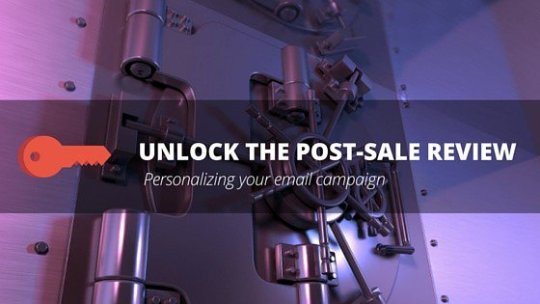
Personalising emails will help conversion
Does the word solicit make you cringe? Since the days of the door to door salesmen, solicitation has become synonymous with an unwanted request. But soliciting an online review from a happy customer does not have to be a dirty transaction.
Happy customers love to refer their friends and family to services that they know they’d love and benefit from, but why limit them to the people they know?
Sharing their experience with prospective customers they don’t know can widen your net when fishing for new customers.
The way you interact with your customers after they have used your service is an incredibly personal experience.
Why would they want to receive an impersonal email or text from you requesting them to spend their precious time and energy writing an online review for your company when there’s no apparent benefit to them?
That’s why your follow up request for a review needs a little tender love and care. A bit of personalisation can go a long way.
Let’s take a look at what you should be considering when crafting a post-sale email campaign:
★ Message value, purpose, length, and clarity
★ Personality style, branding, and voice
★ Campaign timing, frequency, urgency and deliverability
★ Conversion analysis, optimisation, and testing
Email Campaigns for Online Review Generation
The body of your email templates deserves considerable attention and fine-tuning lover time.
Just because you’ve set up an automated email campaign for your customers after they’ve used your business, doesn’t mean you can use any old boring template and expect results.
Your messaging needs to have a clear purpose, specific directions to achieve that purpose, an appropriate length, and value.
For acquiring online reviews, the email doesn’t need to be complicated or difficult to write, but you need to consider these aspects so you’re not shooting yourself in the foot.
Stick to Your Purpose
In this case, the purpose is clear.
You want your customers to open the email, read the message, and move directly on to completing a positive online review for your company. This is not the time to highlight your social media channels, recent blog posts, or newest promotions. The point of this email is to get a review. That’s it.
Before crafting your emails, think about exactly what you want the customer to review. Would you like them to explain what they like about the product? Should they name the person that helped them?
Action tip: Write down a list of the things that would make the review helpful for other customers before you actually write the email template.
The Art of the Prompt
Most people are not idiots, but they’re not psychic either. They can follow simple directions if you provide them. As mentioned above, you now know exactly what you’d like your most recent customer to focus on when writing their online review. When you sit down to write the email, provide some specific prompts to include in the body.
If you do want them to name the person that helped them, then include a line explicitly saying:
“How was your experience with the person who helped you? Let us know who it was so we can let them know!”
Requesting specific details will add more value to the review. Don’t forget to add the exact link that you want them to follow. When sending a customer to a 3rd party review site via email, remember that they’re leaving your sphere of influence. If there are specific instructions on how to use a specific online review site, include them in your prompt.
Consider the Length of Your Email
We know that we struggle sometimes with limiting our word count. There’s so much we want to convey! But if your email is too long, the recipient will never get to your call to action. Try to keep your email concise. It’s important to let your personality shine through, but do it in a way that’s not a distraction from the goal of the email.
Personality Style, Branding, and Voice
Different industries tend to get stereotyped based on their history. Some industries appear conservative in their professionalism like lawyers, doctors, and B2B services, while others differentiate themselves with more a bombastic approach like nightclubs, fashion retail, and entertainment.
You know your audience better than anyone else, and you’ve worked hard to solidify your brand’s identity and personality. Even if you’re in a more professional industry, find ways to appear human in your tone.
A conversational approach to emails are more endearing than a standard generic template. Speaking to the recipient by using “you” instantly boosts that connection.
Action tips for adding some personality into your email:
★ Create a “thank you” video.
★ It doesn’t have to be very long, in fact keeping it under a minute is ideal. Pick someone from your company that comes across well on video and epitomises your company culture.
★ Tell a short story.
★ Did an online review recently help another customer? In 2-3 sentences, share how that previous customer’s review helped other people decide that your company was the right fit for them.
★ Share a tip for the next time they want to use your company.
★ Include a short ‘pro-tip’ for them to have an even better experience next time. Do you have a special trivia night on Thursdays? How early in advance should they schedule their next appointment?
★ Remember that even though you’re providing a tip, this isn’t the time to include a link that diverts from the call to action.
Further Tips for getting a good Online Review
One nice aspect of automated email campaigns is that the timing will be predetermined.
You’ll want the first review request email to go out while the experience is fresh in the customer’s mind, especially if you’re hoping for them to include specific details in their online review.
A three email campaign dripped out over the course of one week is a sweet spot for conversion. Too many emails in a short amount of time will annoy your customer, but people are forgetful, so you don’t want to only send one email, and be done with it.
That being said, you want to increase the urgency of the message with each email.
Action tips for increasing urgency:
★ Second Email: Highlight Review Importance and Value Their Time
In the second email, acknowledge that you’re following up on the first. Highlight the importance of the online review while the experience is fresh in their minds, and show that you do value their time.
★ Final Email: Use Time-Sensitive Language
While you don’t want to make a customer think that they've run out of time to submit an online review, you can use some time-sensitive language that urges action. You can even make it humorous,
“I know my memory fades more quickly as I get older. We’d love for you to share your experience before your memory fades too!”
If your relationship with your customers is ongoing, like a doctor or lawyer, you might want to set up a long-tail campaign that starts with the three emails in a week, but then occurs on a monthly basis until you secure that review. The longer the relationship with the customer, the better the online review you’ll receive, so don’t let those long time customers slip through the cracks.
If At First You Don’t Succeed, Try, Try Again.
Once you have your review funnel set up, you can begin to see how successfully your email campaigns convert. While you can begin to analyse after a couple of weeks, I’d recommend allowing a month to pass to secure your online review conversion benchmarks.
Having your conversion metric baseline allows you to begin testing what’s working and what can be improved. When it comes to A/B testing your email campaign, you need to approach your experiments like a scientist. In order to know how your changes are impacting your conversions, you’re going to want to make one change at a time. It’s tempting to completely rewrite your email and see if that works, but there are so many variables when you make multiple changes that it can be difficult to identify which part of the change increased or decreased your conversion rate.
Here’s a list of components to test over the course of a year:
★ Subject Line
★ Greeting
★ The first sentence of the email
★ Main value sentence
★ Call to action (Button vs link, Button colour, messaging)
★ Any other components of the email (graphics, video, designed html email vs text email, photo of the person who sent the email)
First, you’ll want to craft a spreadsheet to track the changes and conversion rates. Depending on the number of potential users that enter your review funnel (look for at least 10 per week), set up a 1 to 2-week window of testing. After the time frame is complete, you can compare the conversion rates. If it worked, keep the new copy and try to change something else for the next window. If the conversions decreased, return to the original copy and restart the process of A/B testing.
Final Thoughts on getting an Online Review
Collecting reviews is an ongoing process. Every single online review you receive has value. Even negative reviews reveal insights into what might not be working with your product or customer service. Take that info and apply it to your business to improve the happiness of your customers and your future reviews.
Optimising that review generating email campaign will give you the best chance to nurture a dynamic online review stream that sets you apart from your competitors.
Did you read our article about looking beyond the review star ratings?
if(window.strchfSettings === undefined) window.strchfSettings = {}; window.strchfSettings.stats = {url: "https://mylocal.storychief.io/post-sale-online-review?id=109645947&type=2",title: "Unlock the Post-Sale Online Review: Personalising Your Email Campaign",id: "2fa00077-23a5-4f07-b556-c811dc12f64f"}; (function(d, s, id) { var js, sjs = d.getElementsByTagName(s)[0]; if (d.getElementById(id)) {window.strchf.update(); return;} js = d.createElement(s); js.id = id; js.src = "https://d37oebn0w9ir6a.cloudfront.net/scripts/v0/strchf.js"; js.async = true; sjs.parentNode.insertBefore(js, sjs); }(document, 'script', 'storychief-jssdk'))
https://mylocal.org.uk/uncategorized/post-sale-online-review/
0 notes
Text
Look Beyond the Review Star Ratings
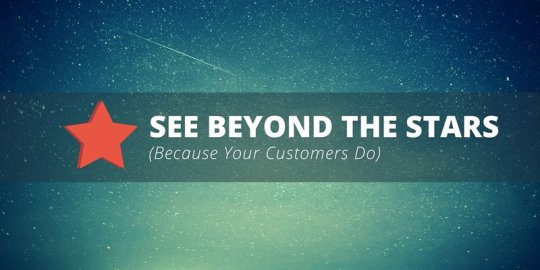
Review Star Ratings
Is your Review Star Ratings all that you are aiming for? Your customers will dig deeper than that and so should you. What really makes for a great online review?
I wish I could tell you that there’s a “one-size-fits-all” approach to online reputation management.
The reality is that everyone digests online reviews differently.
The woman who’s searching for a new doctor will be looking for different types of information than the man who is deciding on which baby pushchair is best for his 2-year-old.
Online behaviour is a fickle beast. While there’s no denying that people depend on reviews sites more than ever, they are more discerning of the types of reviews that influence their purchasing decisions than they’ve been in the past.
Think about how you sift through reviews when researching a product. If you’re looking to book a reservation at the perfect hotel for your holiday to Bali, what are the important factors that would influence your search?
Some holidaymakers might be focused mainly on price and value, whereas others might require certain amenities or a prime location.
“Review Star Ratings will lure a prospective customer into investigating your reviews, but real persuasion happens in the written content”.
So what constitutes a valuable review for your business?
Here’s what to look for:
★ It has a decent star-rating attached
★ It is substantial, and therefore credible
★ It is recent and corroborated by other, similar opinions
The Review Star Ratings Must Align
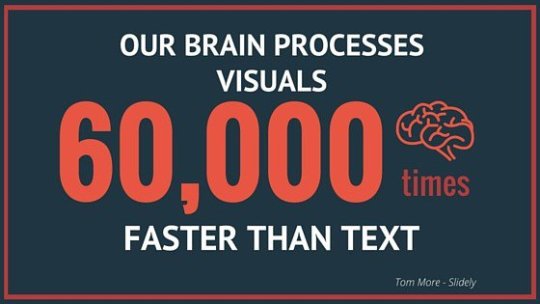
Visual Review Star Ratings are quickly processed
It makes sense that review star ratings have the biggest impact on us when we’re browsing reviews. That visual cue is typically the first thing our eyes gravitate towards when comparing different solutions.
The Search for the Great Steak Enchilada

When people read reviews, they typically have a specific need and are either looking for experts to guide their decisions or someone similar to themselves who can inform them on the practical benefits of a product or service.
Imagine coming across a Mexican restaurant listing with 100 reviews, almost all of them with 4 or 5 Review Star Ratings.
You think to yourself, “Oh, this place looks good! It’s not too far from me. It’s in my price range. Seems to be universally liked. I wonder how tasty their steak enchiladas are?”
Then, you begin to read what people actually have to say about their experience at the restaurant and you start to see a common theme:
“Great food!”
“This was exactly what I was looking for.”
“Good stuff. Yum Yum.”
Well, they seem to all be positive, but they don’t exactly inform us what’s ‘great’ about the establishment.
More information required than just review star ratings
Has anybody tried the steak enchilada?
I’ve had bad enchiladas before, and I bet I can find a different restaurant that’s known for their enchiladas.
Not all written reviews are created equal. A concrete argument with specific details not only makes the reviewer more trustworthy, in that, you can tell they’ve actually used the product, but a specific detail of the experience might actually help the consumer solve their problem.
In the case of my delicious future steak enchilada, if only I had seen a review specifically mentioning my dish.
“The meat was tender and had a smokey flavour that I didn’t expect! The tortilla was fresh and had a hint of sun-dried tomatoes. Thankfully, they did not skimp on their tangy and spicy chipotle sauce.”
I love chipotle sauce! I’m sold. Blog post timeout. I need to go get some enchilada action.
See how a concrete review had much more value to me than someone simply writing “Yum, Yum”?
One of these things is not like the other
Say you’re looking for the best mini-golf course in town. If you’re going to the coast somewhere, there may be plenty of mini-golf courses to choose from.
You find a local course and see 15 reviews that are all raving about the design of the holes and the creative elements of the course in great detail. Then you see one review that complains about how the course lacks creativity.
People will ignore that one bad review because it doesn’t fit in with what everyone else is saying.

Mini Golf Review Star Ratings
Maybe Happy Gilmore decided to take his aggression online after his evil clown encounter.
You’re likely to think that the 14 similar reviews were onto something, and that one negative review is probably from a chronic whiner, or someone who just had a really bad day and took it out on the poor mini-golf course review listing.
Consistency across reviews adds to the credibility of the golf course. While the outliers might provide a strong argument, and be taken into consideration by consumers, they do not have the same impact on the customer’s perception of the business.
Pro-tip: When you’re prompting a customer for a review, use persuasive copy that highlights the importance of specific reasons why they loved your product.
Good Review Star Ratings but their last review was 3 years ago?
A review from this past week is more important than one last year. There’s nothing more frustrating than sifting through reviews only to realize that the most recent review was in 2017.
A lot can change for a business in one year, let alone three!
A review written after 6 months only has relevance to 16% of people. That means that if you haven’t earned a review in half a year, you’re doing a huge disservice to your business.
Funnelling reviews for your business is an ongoing process. It’s not like you can earn 20 reviews, give yourself a pat on the back, and abandon any efforts to continue to secure online reviews.
Ask and ye shall receive
When companies request reviews, the customer is doing a favour to the business.
Simply asking for a review from a recent customer though isn’t enough. People write reviews to help others, yet the average person doesn’t know what constitutes a good review, let alone how to write one.
Interestingly Yelp gets the best reviews because it forces a minimum number of words. This causes reviewers to really think about what they are are going to say and to describe their experience in more depth.
If you’re asking your customers for reviews, you need to provide a little guidance. By highlighting the importance of the written part of the review, as well as distinctly asking for the customer to address specific attributes of their experience, you’re setting reasonable expectations for your customers to be able to provide valuable reviews.
Do you have any recent reviews that have the type of substance that speaks to potential new customers?
Respond to Reviews to add substance
If there are no recent substantive reviews you may consider fixing that with your response. Most review sites allow you to respond. Going back to the example above, if someone just says “This was exactly what I was looking for”, add information in a response. You could say “We are so glad that you enjoyed our homemade enchiladas and spicy chipotle sauce. In fact, all our ingredients are carefully sourced so that you experience how home-cooked enchiladas should taste.” You can adapt this principle to your own business and introduce terms (keywords) that you want people and Google to associate with your brand.
Did you see our recent post on how to take amazing photos for your business?
if(window.strchfSettings === undefined) window.strchfSettings = {}; window.strchfSettings.stats = {url: "https://mylocal.storychief.io/look-beyond-review-star-ratings?id=1711101563&type=2",title: "Look Beyond the Review Star Ratings",id: "2fa00077-23a5-4f07-b556-c811dc12f64f"}; (function(d, s, id) { var js, sjs = d.getElementsByTagName(s)[0]; if (d.getElementById(id)) {window.strchf.update(); return;} js = d.createElement(s); js.id = id; js.src = "https://d37oebn0w9ir6a.cloudfront.net/scripts/v0/strchf.js"; js.async = true; sjs.parentNode.insertBefore(js, sjs); }(document, 'script', 'storychief-jssdk'))
https://mylocal.org.uk/online-credibility/reputation-management/look-beyond-review-star-ratings/
0 notes
Text
How to Take Amazing Photos to Promote Your Local Business

How to Take Amazing Photos
Customers are judgmental, help them with some amazing photos.
In fact, we're all judgmental, it's scientifically proven. Contrary to popular belief, being judgmental is necessary. When customers look at your business they make a judgment call, automatically.
Yes, No or maybe.
It's an unpopular thing to admit that we sort people, businesses and things based on their appearance.
But it's true.
Job applicants who look the part often do better in interviews. Well-dressed people who drive nice cars are viewed as wealthy. Attractive, well-presented businesses are viewed as more successful.
This caused scientists to ask a question.
Are customers judgmental?
Absolutely.
Alex Todorov and Janine Willis, Princeton University psychologists, discovered in their research that people respond to faces instantly.
Customers form first impressions in as little as 50 to 100 milliseconds.
Customers are making judgments about you and your business before they've had a chance to think about it. This first impression is visual and based almost entirely on emotion.
That's a big problem.
We're taught to believe a lie
The lie goes like this:
"It doesn't matter what you look like on the outside, it's what's on the inside that counts."
Remember that?
When it comes to marketing this is an absolutely dangerous lie. Customers should make judgments about the organizations they do business with.
The wrong choice can be devastating.
They can lose money, time and resources. They can be hurt, humiliated or punished for making the wrong choice.
Amazing photos guide a customer's choice
Amazing photos, regardless of your industry, are important. They give customers the information they need to properly evaluate your business.
It shows customers what to expect.
Most of the time, this evaluation process operates at a subconscious level. Customers use the information they've accumulated to make instant, gut reactions. Their assessment is fuzzy, quick and imprecise.
What exactly are customers evaluating in your photos?
1. Ingroup/outgroup. Simply put, customers ask themselves the question, "Are you like me?" If the answer is yes, the conversation continues.
2. Social class. Sadly, classism is viewed by many as the last acceptable prejudice in the world today. Customers use this to vet/validate the social standing of those they associate with.
3. Ethos and values. Every group has its own culture, its own set of values and norms. Customers expect your Ethos and values to align with theirs and the ethos and values of the group to earn their business.
4. Trustworthiness. "Will you hurt me?" Customers want to know they're safe with you. They're looking to decrease risk, pain and suffering.
5. Social status. Businesses with high social status and high social capital command a considerable amount of respect and prestige. As people, we're drawn to those around us who are exceptional in some way.
Local businesses tend to neglect photos, or they'll simply post unflattering photos that position their business negatively.
Not good.
But customers are absolutely looking for more photos. How do we know that?
They tell us. And Google tells us – just look at your Google My Business Insights.
Poor imagery kills the sale
A recent study from the National Retail Federation in the USA found that 94 percent of customers felt image quality was “very” to “somewhat important” in their buying decision.
Isolate women's responses and that number climbs to 96 percent.
Look at Yelp's top restaurants of 2017 and something interesting stands out. Each of these restaurants have hundreds and thousands of positive reviews and images.
Customers want to see…
★ High quality photos
★ Demand (e.g. lots of customers if you're a service business)
★ Alternate views (e.g. different views of product/business)
★ Topic specific images (e.g. cakes, tables, interiors, etc.)
★ Color changes, where appropriate
★ True to life imagery (e.g. view on model, customer photo of food, etc.)
★ View(s) in a room
The keywords here are quality and variety.
Customers want to see your business from more than one perspective. More photos give them the ability to evaluate consistency.
You'll never be able to take the perfect photo…
If you focus your time and attention on all these specific variables. It's overwhelming and simply too much for the average business.
You still need amazing photos though.
So, what do you do?
You focus on your ideal customers, the customers you'd fight tooth and nail to keep. Then use photography to present your business in a way that wows them.
How do you do that?
You focus on their wants and needs. If you're a fine dining restaurant looking for big spending regulars you show…
★ A pristine environment
★ Influencers who frequent your restaurant
★ A high class image (e.g. dinnerware, table cloth, attire, etc.)
★ Exclusivity markers (e.g. wait list, limited seating/hours)
If you know your customers, you know this is what they expect.
What if you're the owner of a Blues and Jazz cafe, like Blues City Deli and you're looking to attract more customers? With apologies for an example from the USA but the concepts translate well to the UK.
Step #1: Know your audience
You confirm the demographics and psychographics of the customer segments who are (a.) willing to pay and (b.) able to pay.
Then you figure out what makes them tick.
Their desires, goals, fears and frustrations. Their expectations from a Blues Cafe, their reading habits, how they spend their free time etc.
I wanted to know so I referred to a study by the Jazz Audiences Initiative (JAI).
They broke listeners down into six groups:
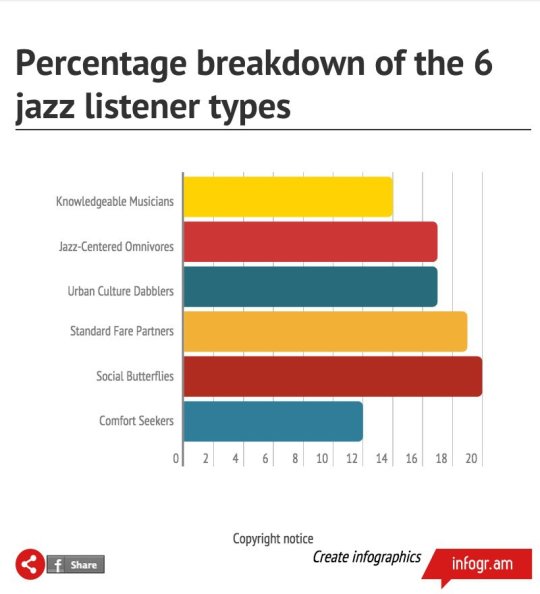
Research for Amazing Photos
They sorted them by education level:
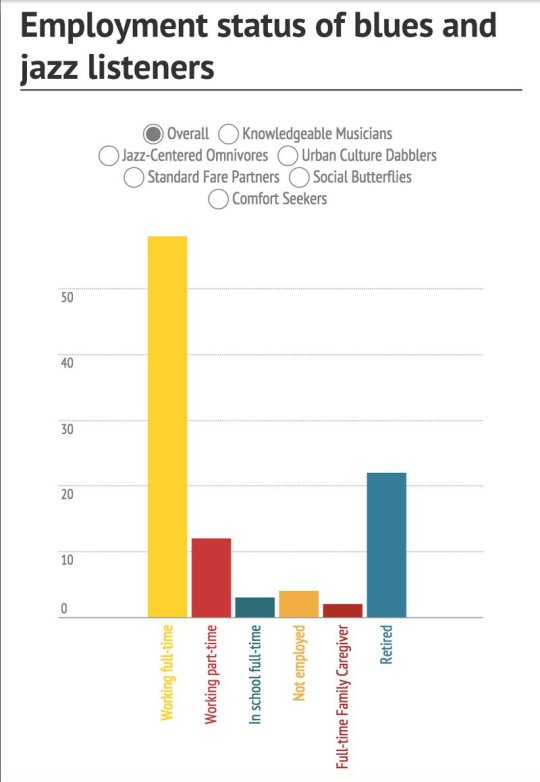
Research for Amazing Photos
By education status:
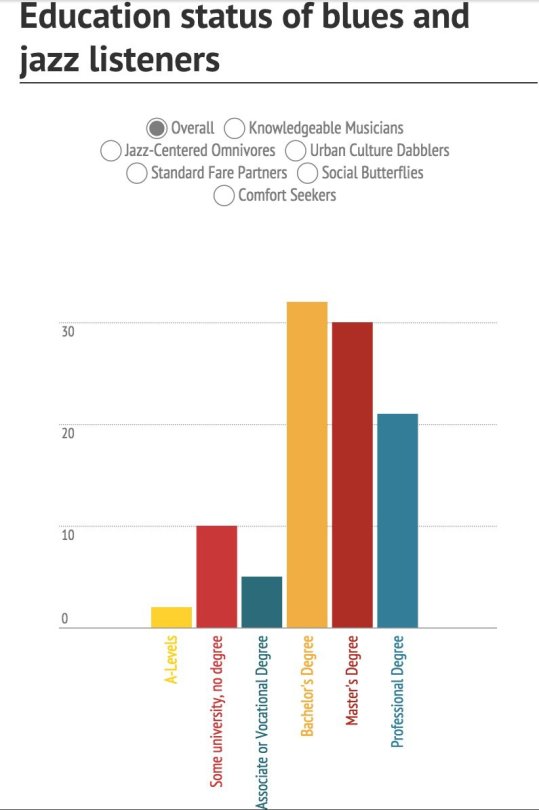
Research for Amazing Photos
And marital status:
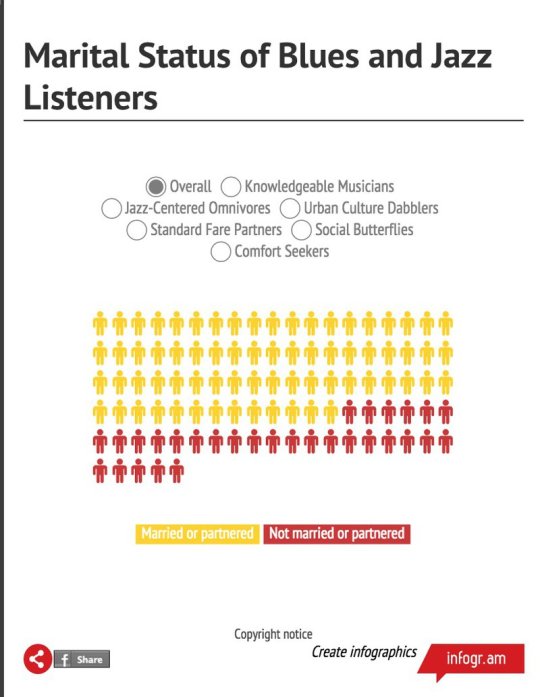
Research for Amazing Photos
So, with less than an hour's worth of research we know our ideal customer is:
★ A member of at least one out of six groups
★ Highly educated bachelors or above
★ Works full-time (which means discretionary income) or retired
★ Married or partnered
Armed with this research you're ready to…
Step #2: Reject the wrong people
Customers judge, remember?
Your photos don't have to be Smithsonian worthy but they should convey quality. Product, ambience oriented photos aren't about showing off your photography skills, it's about sending a message.
Customers are subconsciously looking for specific cues on:
★ Ingroup/outgroup
★ Social class
★ Ethos and values
★ Trustworthiness
★ Social status
Which is exactly what Blues City Deli does.

Research for Amazing Photos
See what they did there?
The right message is easy to convey if you attract the right audience.
Do the upfront work to attract the right audience and these details mostly take care of themselves. That's the problem though. Most local businesses don't do the upfront work.
So they struggle.
They attract the wrong people who, in turn, repel the right people.
Step #3: Take amazing photos
Remember, you're not looking to win a photojournalism award. You're looking to send a message.
Which is exactly what Blues City Deli does.
They share photos about their history.
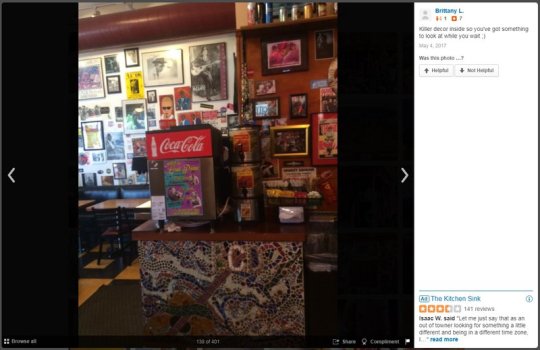
Research for Amazing Photos
They convey status, showing they're so good customers are willing to wait.

Research for Amazing Photos
They sell the ambience.

Research for Amazing Photos
By inviting you to listen to Live Blues with them, they're telling you they're part of your ingroup. They're one of you.
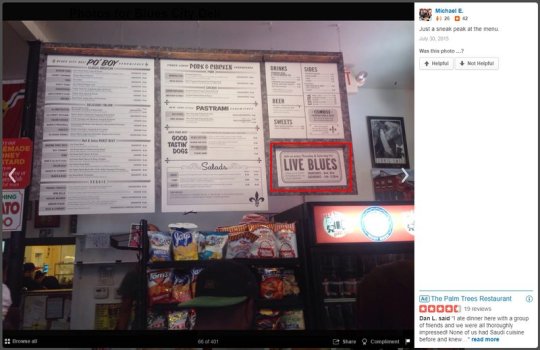
Research for Amazing Photos
Something interesting is happening in their photos, can you see it?
No?
Did you notice the similarities between their customers? The style of dress, the attitude, demeanour and presentation?
That's homogeneity.
Take photos of your business; post, share and promote them on your local listings and profiles.
Step #4: Get customers to willingly promote you
How?
How on earth do you get customers to willingly promote your business, product or service?
It's simple.
You make your customers the hero of the story. You share your prestige with them. It's different for every business but there are all kinds of ways this can be done.
You could…
★ Get customers to join in on Live Blues night
★ Run a contest, then promote the winner
★ Brag about specific customers in a case study or testimonial video
★ Ask customers for advice, follow it, then show them that you did
★ Remember (and act on) specific things about your customers (e.g. birthdays, the anniversary of their first visit, bad day or tragic events, etc.)
★ Surprising/random acts of kindness and generosity (done as a habit).
See the secret? It's honour.
When you honour customers you're showing that you cherish them. That the relationship is more important than just "money".
Find a way to honour customers in a way that's meaningful to them and they'll find a way to share it with everyone. It's wonderful because you've given them a way to brag without bragging.
Sure sounds good, but it will backfire
Asking customers to share photos is a terrible idea. What if you train customers to "take pictures" and you make a mistake? You've given them everything they need to hang you.
That is true if you have a bad relationship with your customers.
Mistreat your customers and they'll eagerly wait for the chance to take you down. They'll tell their whole world, anyone, who'll listen about your failure.
If customers are neutral that's far less likely to happen.
Most customers don't write reviews. They read them sure, and most base their buying decisions on them. That much is true.
But the vast majority aren't willing to share their bad experience.
If you have thousands of reviews like the local businesses we've covered they're even less likely to share (though they should). They're less likely to spill the beans on your mistake if you have a good relationship or rapport with them.
Does that mean you should count on that?
No.
But you're far less vulnerable than you've been led to believe. If you're running a wonderful business you can counteract that.
Customers are judgmental, they should be
We're all judgmental, it's a necessary, scientifically proven part of life.
Customers are making judgments about you and your business before they've had a chance to think about it. This first impression is visual and based almost entirely on emotion.
Give customers what they're looking for, meet their wants and needs, and you'll find their judgment swings in your favour.
if(window.strchfSettings === undefined) window.strchfSettings = {}; window.strchfSettings.stats = {url: "https://mylocal.storychief.io/how-to-take-amazing-photos?id=340874733&type=2",title: "How to Take Amazing Photos to Promote Your Local Business",id: "2fa00077-23a5-4f07-b556-c811dc12f64f"}; (function(d, s, id) { var js, sjs = d.getElementsByTagName(s)[0]; if (d.getElementById(id)) {window.strchf.update(); return;} js = d.createElement(s); js.id = id; js.src = "https://d37oebn0w9ir6a.cloudfront.net/scripts/v0/strchf.js"; js.async = true; sjs.parentNode.insertBefore(js, sjs); }(document, 'script', 'storychief-jssdk'))
https://mylocal.org.uk/online-credibility/reputation-management/how-to-take-amazing-photos/
0 notes
Text
7 Unique Email Templates For Requesting Online Reviews
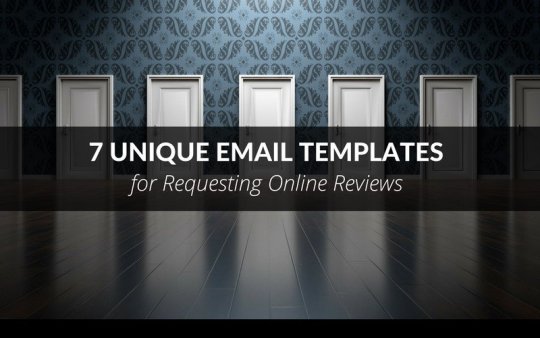
Requesting Online Reviews
Are you requesting online reviews from customers? They hate it when you ask.
You know it, they know it. But experts are encouraging you to do it. "Ask your customers for reviews," they say. "You'll regret it if you don't," they imply.
Over and over you're bombarded with advice that tells you to get out there, go grovel and beg for that review. Your business needs it. So, suck it up and swallow your pride.
If you're like most people you hate it. And you know what? That's a healthy response. You should hate grovelling because it's the wrong way to ask for a review from a customer.
Begging ruins relationships with customers
What happens when someone begs us to do something we don't want to do? It hurts the relationship.
It creates negative feelings – bitterness, resentment, loss of respect – feelings that weren't there before. Maybe we do what they want us to do, maybe we don't.
The relationship is permanently changed.
Beggars put themselves in a one-down position, a place that leaves them at a serious disadvantage. Okay, what does that disadvantage look like?
★ Condescension becomes more obvious
★ Customer distrust, regarding your motives, grows
★ The customer/provider relationship becomes a little bit more inflexible
★ Customers become more resistant to suggestions, requests and expectations
The damage is far-reaching, continuing to get worse until the state of the relationship is openly addressed and discussed.
Which almost never happens.
Most businesses do their best to avoid conflict with customers, while customers discuss their feelings with anyone and everyone, except those they're doing business with.
Notice I didn't say they don't talk about their problems. I said they don't talk about their feelings.
This sounds like touchy-feely nonsense
The kind of "emotional claptrap" many people do their very best to avoid. But is that really the case here?
Actually, no.
Because the behaviour, begging for reviews, is the problem. Most of us would avoid begging if customers pointed out that behaviour.
If they told us our begging made them angry or uncomfortable, most of us would stop doing it. We'd find a different way to go about getting the reviews we need. Here's the problem.
They don't like it.
What's worse, it permanently changes our status, in our customers' eyes, as peers. Most of the time it's pretty subtle but the results are still the same. Begging hurts relationships.
We still need reviews though, so…
What do we do?
Do we simply abandon our efforts to get quality reviews? Do we avoid reviews altogether because we're embarrassed or afraid?
No, we stop asking for reviews.
We start asking for specifics, the things inside our reviews. We ask for details, specifics on the objections they had as new customers coming in.
Asking for a favour actually tends to boost customer response, significantly increasing the odds we’ll get more favours in the future. Asking isn’t begging and it’s actually an important relationship-building step to take.
So what kind of specifics are we asking for?
We ask about their fears, frustrations and doubts. Their objections, risks and consequences. Did they take a huge risk on your business or your product? Were they burned by a competitor? It's important that you find out. Making a face-to-face request is ideal, but it’s important to get feedback (or reviews) whether it’s face-to-face, over the phone or digital.
Here's why.
When customers share their story they give you a gift. Independent, third-party validation of you. Your character, the service you provide and the results they received.
A powerful review has four distinct ingredients
★ Presentation. A powerful review is presented well. Their story follows a sequence (linear or chronological) and grammar isn't a distraction. Presentation criteria grow when the medium changes (e.g. audio or video).
★ Consistency. Do reviewers contradict themselves? Inconsistency undermines a reviewer's credibility. Which means prospects distrust both the business and their reviewers.
★ Negativity. As John Cacioppo's research shows, humans have a negative bias. We're more drawn to the negative. Reviews with negative elements – fears, problems, frustrations, objections, risks – attract attention and are considered to be more believable.
★ Positivity. Our negative bias creates stress and anxiety. A good solution relieves our stress and anxiety. This is the result most people look for in a review. But reviews that focus on positivity alone are seen as unconvincing and untrustworthy. Don't believe me? What do you think about most LinkedIn recommendations?
This is kind of the worst.
We shouldn't ask for reviews, now on top of that, we need four specific ingredients?
Then, to make matters worse, these ingredients are things customers have to choose to provide on their own. So, what are you supposed to do?
You follow a system.
A good system for Requesting Online Reviews relies on templates
Templates give you a rough framework to follow, showing you the who, what, why and how. Ideally, templates are easy to apply and quick to use. They're helpful training aids your entire team can follow.
So with that in mind, here are 7 templates you can use to get amazing reviews from all-star customers.
Template #1: Feedback interview
Most of the time customers come to us with a problem. It could be a complex marketing problem (SEO) or something as simple as boredom (YouTube). Whatever their motivation they come to you looking for a solution.
Customers are happy when you fix their problem. But they forget to share their experience with others.
The feedback interview solves this problem.
How does it work? You simply ask customers for their feedback on one particular problem like this.
Hi Jan,
Some of our clients were burned by [competitor]. Most of them paid lots of money for a phone system that didn't work well. We're trying to learn from their experience.
Have you run into any frustrating problems while using our phone system? Would you be willing to share your story on a quick 5 minute call?
We're looking for brutal honesty.
Appreciate you!
Andrew
The feedback interview works because it's a two-pronged attack. First, you're learning about potential problems before they become disasters. Second, your identifying customer candidates who are willing to give you a review.
This template works best as a follow-up strategy. After a customer has opted in, purchased or used your product.
Template #2: Survey interview
Most businesses have a list. An audience of people who are interested in what they have to say. An email list, social media following or group membership.
The survey interview is, as the name suggests, a survey. It's a one-question survey that leads with something fascinating. A question or hook that's guaranteed to grab their attention.
Here's how it works.
1. What do you want to know? Choose the most important question you'd like to ask e.g. what's the biggest problem you're trying to solve?
2. Why should they care? Make your question attention-grabbing, avoiding explicit controversy and self-deprecation.
3. Segment your responses. Who provided the best/worst answers? Which answers are most valuable? Sort the respondents into groups.
4. Follow up with the engaged. Reach out to the people you'd like to hear more from. Send them a message thanking them for their response and asking if they'd be willing to elaborate.
If you're running a marketing firm, your one question survey could be anything along the lines of:
★ What do you hate most about marketing firms?
★ What's your biggest struggle with creating content?
★ What's your biggest risk factor when it comes to paying for SEO?
★ What would make an unknown marketing firm unique from your perspective?
And the most important part? You target existing customers with your one question survey.
Template #3: Unhappy customer
If you're running a business you're bound to have a few unhappy customers. Customers won't always be happy with the work we do. Sometimes we make mistakes, sometimes we don't meet their expectations.
Sometimes these customers leave.
It's common for businesses to treat these customers like a lost cause. "I made a mistake, they're really angry with me and they're gone forever."
What if you could get them back?
What if there was a chance you could win them back and win new customers over in the process? As it turns out you can.
Here's how:
1. Assess your customer. You're looking for unhappy customers who are emotionally stable. The strategy won't work with unhappy customers if they're toxic or malicious. You're looking for unhappy people who are honourable even though you screwed up.
2. Ask for details. These customers may already be on their way out the door. If they're willing, give them a chance to clear the air. Ask questions if you need clarification, but listen. Get their permission to record and transcribe the interview.
3. Ask them to share their feedback. Send them a copy of their unedited feedback. Then ask if they'd be willing to share it publicly as a review. That's right, you're asking them to share a negative review.
4. Fix the problems they've mentioned. Go above and beyond, fixing all of the issues your unhappy customer mentioned. Next, create an irresistible offer that's designed to woo them back to you e.g. if you’re running a ski resort you could reach out to unhappy customers with a free 10 day pass good for 10 people.
5. Make your approach. The approach is key. Come on too strong and look needy. Allow your ego to get in the way and they may update their review, making your situation worse. The whole strategy falls apart. Your approach needs to be gentle, nuanced and respectful.
Your initial approach could look a little bit like this:
Jan,
We've really messed things up. I'm so sorry. I know where we went wrong but I think I'm missing something. I'd like to learn as much as I can from this.
Would you be willing to share where you think we went wrong?
This isn't a ploy to try to keep you with us. I want to prevent this from happening again.
Andrew
Who in their right mind would do this?
All-stars businesses who are looking to set the standard in their field. But why? Why go out of your way to request a negative review?
Because customers know the truth about reviews. How do I know?
Yelp.
Here's their policy on requesting reviews:
"Don’t ask anyone to review your business on Yelp. It’s that simple.
Most businesses would ask their happiest customers to write reviews, not the unhappy ones. Self-selected reviews tell only part of the story, and we don't think that's fair to consumers."
Ouch.
They have a point.
And believe it or not, this is something customers recognize intuitively. When they look at your site and they see nothing but glowing reviews, they wonder.
What about unhappy customers?
This strategy shows everyone your business is different. But, it depends on an incredible amount of nuance. This is something only the most sophisticated businesses will try.
Most won't do it.
Those who do, the ones who do it well, can benefit from this tremendously. You get an insider's view of what went wrong, the information customers typically withhold, and you get direction. You also get a chance to show you're objective and honest, even when it hurts.
Word spreads fast.
At some point, people will begin talking about what you did. They'll share your story with others. And the natural outcome? Customer trust skyrockets. But only if you're patient and you allow this strategy to grow organically. Talk yourself up, brag about what you did, let your ego get in the way at any point, and this may blow up in your face.
Template #4: Post-transaction request
The best time to ask for a review is right after a customer has given you money. After a visit to a doctor's office, at the end of a landscaping project or after the first marketing campaign. The best time to ask customers for a review is at the end of the transaction. Why? Because the details are still fresh.
Here’s how you can ask:
Hi Jan,
Thanks for choosing [your business]. I wanted to reach out personally and ask about your experience.
What was your experience like? (e.g. amazing, terrible, etc.)
We want to be better. Your feedback helps us accomplish that. If you're willing, it only takes a minute or two.
Share your review here [link]
Thanks for your trust,
Andrew
Template #5: Applause inquiry
Sometimes you get things right. You were amazing, you under promised and over delivered. Your customers are happy, overjoyed even. This is the part where businesses ruin it. They beg for reviews or they neglect to ask for feedback.
When your customer is happy it's a great time to ask for feedback. What specifically made them so happy? Did they dodge a bullet or avoid some painful outcome?
There's an art to it. When you're getting applause, asking for feedback is risky if it's mishandled. If customers feel you're being greedy – the relationship can sour quickly.
"Which is the perfect time to use touch and go."
With touch and go, you ask one question then you move on. You make one request then it's back to celebrating. If customers are happy our questions need to be neutral or pleasant, this isn't the time for controversy and alarm.
Thanks, Jan!
We're happy that you're happy! 🙂
It was a lot of hard work but we did it together! Thanks for trusting us!
Any thoughts on what we can do to make this even better for you?
We love working with you!
Andrew
We've sandwiched our request between two, very genuine compliments doing our best to keep the mood positive and upbeat. Here's the thing. Our customer may not have a very good answer. That's okay.
Because it's all about planting a seed.
When things are back to normal, reach out with a reminder. "Is there anything we can do to make these results even better for you?" If they've already given you an answer simply ask the next question on your list and go from there.
Template #6: Reasoned invite
Inviting a customer to review your business isn't the same as asking for a review. When you ask it's a favour, when you invite its prestigious.
But only if you do it right.
Hi Jan,
I’m reaching out to the top 3% of our customers (you’re one of them :)). I had six questions I wanted to ask, should only take 4 or 5 minutes.
Would it be alright if we talked on the phone? I’m free tomorrow at noon.
Andrew
Can you see what's happening? You're not a beggar trolling random customers for reviews, you're a discerning business owner choosing sophisticated customers.
With positioning, you change the game.
What if you can't target the top 3% of customers in your business? Can you still use positioning to your advantage?
Sure.
Just find a way to segment your customers. It's completely up to you but here are a few examples you can use to get started.
★ Most engaged/loyal/profitable customers
★ Your most vocal customers
★ Customers in a specific industry or niche
★ Customers with a certain amount of revenue
You see where I'm going with this?
When you set the terms, it shifts a customer's focus, getting them to compete for the label you're using in your positioning. Here's the catch: this strategy works best in a prestigious conscious environment. A prestigious industry, customers who are prestigious conscious or desire prestigious distinction.
The most important part goes without saying. Identify prestige, don't manufacture it.
Template #7: Free trial follow-up
If free trials are a big part of your business, this strategy is a great way to convert trial users. Here's how it works.
You're looking for engaged users, people who've signed up for a free trial and are actually trying things out. They're uploading their information, creating reports, working with your API.
They're taking things seriously.
These customers deserve more of your attention. Your onboarding user flow should guide these customers along, giving them the support they need to make a yes or no decision.
Reach out for feedback near the end of their free trial.
Hi Jan!
You've got three days left on your free trial. What was the most frustrating thing about [our product]? Any thoughts on how you'd make it better?
You're number one!
Andrew
When it comes to free trials, customers are sensitive. They don't want to be sold. They also don't want to be harassed, bullied or coerced into buying a product. They want to choose the product that's right for them.
They're still going to be suspicious though.
Which is why we've kept the tone positive, light and encouraging. We want them to know we appreciate them either way. Let's say they get past that and they decide to talk to us. How do we handle that?
One question at a time.
When they answer our first question, we ask the next/follow-up question limiting things to five questions or less.
These templates won't cover everything
They're not intended to and that's okay. These templates are really about changing your mode of thinking. The situations and circumstances you experience are opportunities. Use them well and you attract more customers.
Ignore them and you'll get more of the same, nothing.
That's the point though, isn't it? Once you've trained yourself to look for opportunities you'll see them everywhere.
What if these templates don't work?
What if these templates aren't a good fit for your business? Change them, modify them, find what works for you. These templates aren't a one-size-fits-all proposition. The opportunity is there if you're willing to do the work.
As long as you're willing to try.
Customers hate it when you beg
You know it, they know it. But experts encourage you to do just that. "Ask your customers for reviews," they say. "You'll regret it if you don't".
The opposite is true.
Begging ruins relationships with customers. If you're like most people you hate it. And you know what? That's okay. Because there's a better way.
Stop asking for reviews, start asking for specifics. Important details inside the review.
Look for customer fears, frustrations and doubts. Their objections, risks and consequences. Find the details that matter to them and you'll find they're happy to share.
if(window.strchfSettings === undefined) window.strchfSettings = {}; window.strchfSettings.stats = {url: "https://mylocal.storychief.io/requesting-online-reviews?id=502138610&type=2",title: "7 Unique Email Templates For Requesting Online Reviews",id: "2fa00077-23a5-4f07-b556-c811dc12f64f"}; (function(d, s, id) { var js, sjs = d.getElementsByTagName(s)[0]; if (d.getElementById(id)) {window.strchf.update(); return;} js = d.createElement(s); js.id = id; js.src = "https://d37oebn0w9ir6a.cloudfront.net/scripts/v0/strchf.js"; js.async = true; sjs.parentNode.insertBefore(js, sjs); }(document, 'script', 'storychief-jssdk'))
https://mylocal.org.uk/online-credibility/reputation-management/requesting-online-reviews/
0 notes
Text
What has changed in Local SEO?
Google regularly changes its algorithm which can affect Local SEO and the rankings of some businesses. Google’s motivation is to improve the experience of the general public rather than to make things difficult for local businesses. A new service has been developed to monitor these changes and can be seen below.

Google Algorithm Changes
Whenever the monitor goes above a certain number and changes from green it an indication of algorithm changes. The service breaks that down by industry so you can see if yours has been affected. Recently the majority of the changes have been in the hospitality sector.
The major local search factors remain unchanged
Relevance. Relevance refers to how well searches are matching with a local listing. Adding complete and detailed business information can help Google better understand your business and match your Google listing to relevant searches from customers.
Distance. Distance is calculated by how far each potential business is from the location terms used in a search. If a customer doesn't specify a location in their search, Google will calculate distance based on what’s known about their location from their device.
Prominence. Prominence refers to how well-known a business is. Some places are more prominent in the offline world, and search results try to reflect this in local ranking. For example, famous landmarks or well-known brands are also likely to be more prominent in local search results.
A relatively recent change is that prominence is also based on information that Google has about a business from across the Internet (like links, articles and directories). Review count and score are also factored into local search ranking – more reviews and positive ratings will improve a business's local ranking. The business’s position in search results is also a factor, so SEO best practices also apply to local search optimisation.
Google is the New Home Page in Local SEO
Some experts are saying “Google is the new Home Page” for local businesses and this is a definite change. It makes Local SEO even more important than it used to be. What it means is that Google will serve up the entity (local business in this case) that best matches the search query. The entity is displayed in a knowledge panel (on the right-hand side on a large screen device) and provides a summary. The summary includes all the information that Google thinks is relevant.
The net effect of this is that customers no longer need to click through to the website to get the most relevant information. Hence Google is the new Home Page. This also means that Google Analytics does not see these searches as they never reach your site.
Google has also improved its dashboard for business listings with additional features such as Products and Services. The features are dependent on the business category as not all businesses have Products for instance. The dashboard remains one of the best tools to help with Local SEO.
Products is a big change as it is related to other Google products such as Google Merchant Center and surfaces across Google. In summary, if you are a store then Google provides an e-commerce platform for you which can be integrated with Google My Business. Even if you are not using e-commerce, you can use the products section in your dashboard if it exists for your category.
The move to Mobile in Local SEO
Another change is the drift towards mobile devices. Google My Business dashboard is available as an App on smartphones and has some unique features such as messaging. Study after study has shown that searches, particularly local searches, are happening more and more on mobile devices. Considering that Google takes the user’s location into consideration, it is not surprising that they would begin to give users on the go the edge in the searches. Today, in order to make the most of Google and its page ranking algorithm, business owners must ensure their websites are mobile-friendly.
A related change is “voice search” which is becoming mainstream with tools like Siri and Alexa. It is likely that further adjustments to websites will have to be made to make them more “voice friendly”.
Facebook has become a Local Search engine and e-commerce platform in its own right. It is quite possible these days for both businesses and consumers to live exclusively in the Facebook world to do business. Facebook owns Instagram and it is possible to set up a Store on either platform which is similar to using Google Merchant Center. It is not a recommended business strategy but it just shows how far Facebook has come. Both Facebook and Google are targeting the success of Amazon and eBay with their merchant offerings.
About MyLocal
We work with your website designer to improve your ability to be found in Google and other search engines. Also, to look good wherever you may appear online. We specialise in local SEO and most of our work is off-site. But there may need to be some on-site work undertaken by your webmaster to complement what we do. If you would be interested in finding out more, please use the Contact Form on our website.
Do you know what Local SEO typically costs?
if(window.strchfSettings === undefined) window.strchfSettings = {}; window.strchfSettings.stats = {url: "https://mylocal.storychief.io/local-seo-changes?id=1135357682&type=2",title: "What has changed in Local SEO?",id: "2fa00077-23a5-4f07-b556-c811dc12f64f"}; (function(d, s, id) { var js, sjs = d.getElementsByTagName(s)[0]; if (d.getElementById(id)) {window.strchf.update(); return;} js = d.createElement(s); js.id = id; js.src = "https://d37oebn0w9ir6a.cloudfront.net/scripts/v0/strchf.js"; js.async = true; sjs.parentNode.insertBefore(js, sjs); }(document, 'script', 'storychief-jssdk'))
https://mylocal.org.uk/local-seo/local-seo-changes/
0 notes
Text
How much do Local SEO services cost?
As the landscape is constantly changing I performed a Google search to try to find “Local SEO services cost”. For packaged services, the answer that came back was between $199 and $499 per month. A reputable Canadian based company called Whitespark was $349/m and listed their services as

Local SEO services cost from Whitespark
Other well-known companies specialise in providing specific services such as Citation Management. An example of this is Yext which offers a range of plans costing typically about £30 per month. Our view is that the hard work with citations is getting them established and that is worth paying for. After that, they only need to be monitored and that should not cost as much as most companies charge.
Local SEO Set-up versus On-going costs
The majority of Local SEO work only has to be undertaken once, like establishing citations. For instance, once a Google My Business listing is set up and optimised, that job is effectively done and the next one can be undertaken. Comparing that with SEO work, which involves constant ongoing tasks, explains why Local SEO is less expensive than Organic SEO.
Local businesses should, therefore, seek to divide the cost into “set-up” versus “on-going” work. It will be less expensive over the long term if the on-going costs can be reduced as much as possible.
The set-up cost will obviously depend on what needs to be done, and that cannot be determined without an audit. Most suppliers will undertake an audit so that they can provide a quotation, so getting a few quotes is not a bad tactic.
This blog series has listed the main things that need to be done so that business owners can compare quotations in an informed manner. Once the set-up is complete then it is possible to see how you compare with your main competitors. Only then can you decide what level of on-going services you need. If you are ranking number 1 for your main keywords already then you can go with minimal on-going services. If you are not ranking at all then you may need more extensive on-going services.
Local SEO services cost – ask your consultant
There are a number of companies that offer services in this area but great care must be taken in choosing the right one for the job. Some definitely get results but others do not and that is very difficult for the layman to know. That is why working with a Local SEO consultant can be money well spent.
These professionals know everything there is to know about Local SEO, and they can get the business’s name in places – and in front of customers – the business owner will not know about or may have never thought of.
Moreover, because there are so many changes taking place, a good Local SEO consultant will keep on top of the latest developments. A retained Local SEO consultant will monitor the clients’ businesses and make adjustments when required in reaction to these changes.
Where changes to a website are required then it makes sense for your webmaster to make those changes. However, knowing what changes to make should come from a Local SEO expert rather than your webmaster. If changes are required then it indicates that your webmaster did not realise, otherwise the changes would not have been required.
In summary, divide the cost into set-up and on-going. First, get set up and then look to see how you compare with your competitors. Only then decide on your on-going monthly services. Typically the monthly costs range between $199 and $499 for the full range of services available.
About MyLocal
We work with your website designer to improve your ability to be found in Google and other search engines. Also, to look good wherever you may appear online. We specialise in local SEO and most of our work is off-site. But there may need to be some on-site work undertaken by your webmaster to complement what we do. If you would be interested in finding out more, please use the Contact Form on our website.
Want to know how to measure the success of Local SEO?
if(window.strchfSettings === undefined) window.strchfSettings = {}; window.strchfSettings.stats = {url: "https://mylocal.storychief.io/local-seo-services-cost?id=173402024&type=2",title: "How much do Local SEO services cost?",id: "2fa00077-23a5-4f07-b556-c811dc12f64f"}; (function(d, s, id) { var js, sjs = d.getElementsByTagName(s)[0]; if (d.getElementById(id)) {window.strchf.update(); return;} js = d.createElement(s); js.id = id; js.src = "https://d37oebn0w9ir6a.cloudfront.net/scripts/v0/strchf.js"; js.async = true; sjs.parentNode.insertBefore(js, sjs); }(document, 'script', 'storychief-jssdk'))
https://mylocal.org.uk/local-seo/local-seo-services-cost/
0 notes
Text
How can I measure success?
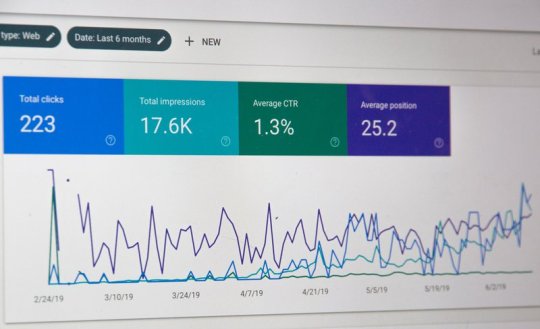
Photographer: Webaroo | Source: Unsplash | How to measure success
It is wise to establish how you are going to measure success before spending money on any marketing campaign. This applies whether it is TV, postal mailshot, email marketing, online advertising, social media marketing, or SEO. This series focuses on Local SEO so we will look at the metrics that could be measured.
Measure Success using Google My Business Insights
The metrics in Google My Business Insights include
Number of Google Searches
Number of Google Map Searches
Direct v Discovery Searches
Number of click-throughs to your website
Number of Direction requests
Number of Phone calls
Number of Photo views
Queries used to find your business
The Insights that are provided as part of Google My Business are not terribly accurate and should not be taken too literally. They are, however, reasonable at seeing trends and whether there has been an improvement over time. In the absence of anything better, they should be studied regularly such as once a month to measure success.
One issue with GMB Insights is that you only get up to 90 days of data in the dashboard. However, you can get more data via Google’s API. This means that some 3rd party tools can provide years of data which can be very useful for trends and comparisons. Some of these tools provide much more interesting insights but there are too many of them to deal with here. Please note that Google’s tools are generally free whereas 3rd party tools are usually charged for.
Brightlocal Monitoring Tools
My clients tend to be monitored using BrightLocal which has a series of reports that add value over time. One shows which businesses rank in positions 1-10 for 5 local keywords so you can see how you compare with your competitors. An advantage of these reports is that you can set the location of the searches. You can also see your competitors’ metrics and work out what you need to do to rank better.
Another 3rd party report from Local Falcon shows your rank for a specific keyword on a geographic grid. This enables you to see if a business only ranks well very close to its location, which it should. The further away from its location, a business ranks the stronger its ranking position is. This is very difficult to test and visualise without such a tool.
There are many other “Analytics” available such as Google Analytics, Google Search Console, and the analytics associated with each social media platform used. There are tools which can pull all of these different data sources together in one report which is perhaps the best solution. The most important thing is to actually look at the data on a regular basis even if only monthly.
Measure Success with Google Analytics
Google Analytics is perhaps the best-known free tool but it is also one of the least exploited. It will only work if you installed on a website and if it has been set up to monitor the right things. For instance, it is capable of measuring “Conversions” provided that goals have been set. I do not know the statistics but I would venture a guess that less than 10% of businesses that use Google Analytics actually set their goals within the system. That would mean that 90% of Google Analytics installations would not measure success.
Google Analytics only looks at “on page” activity (i.e. activity on a website). If a business is well set up for Local Search then most people won’t need to click through to the website to get what they want, such as a telephone number, hours of operation or driving directions. So a lot of the success of local SEO will never be picked up by Google Analytics, hence the need for other measures.
One thing that should be monitored in Google Analytics is “Bounce Rate” which is people leaving a website quickly for whatever reason. The reason needs to be investigated because it may be preventing the business from achieving its goals. Imagine having a high bounce rate and not knowing for days, weeks or months, which would be quite possible in the absence of regular monitoring.
Google Analytics also enables a high degree of segmentation based on things like how long people stayed on-site, which pages they visited etc. It is this aspect that is so rarely taken advantage of even though it is completely free to do so.
Take a hotel with a restaurant and a spa. It would make sense to have pages on its website dedicated to each part of its business. However, if the customer journeys are not being tracked by Google Analytics, there will be no information on them. The hotel will not know which visitors to its website were interested in which service it was offering. It will miss out on the opportunity to market to people who have indicated what they are interested in.
We are getting into territory that goes beyond the scope of local SEO, but the point is that it is important to measure. To summarise
In order to measure success, goals have to be established in the first place.
Measuring systems need to be in place to measure those goals.
The reports need to be studied on a regular basis.
Action needs to be taken based on the observations.
About MyLocal
We work with your website designer to improve your ability to be found in Google and other search engines. Also, to look good wherever you may appear online. We specialise in local SEO and most of our work is off-site. But there may need to be some on-site work undertaken by your webmaster to complement what we do. If you would be interested in finding out more, please use the Contact Form on our website.
Want to know long will it take to see results from Local SEO efforts?
if(window.strchfSettings === undefined) window.strchfSettings = {}; window.strchfSettings.stats = {url: "https://mylocal.storychief.io/how-to-measure-success?id=607483366&type=2",title: "How can I measure success?",id: "2fa00077-23a5-4f07-b556-c811dc12f64f"}; (function(d, s, id) { var js, sjs = d.getElementsByTagName(s)[0]; if (d.getElementById(id)) {window.strchf.update(); return;} js = d.createElement(s); js.id = id; js.src = "https://d37oebn0w9ir6a.cloudfront.net/scripts/v0/strchf.js"; js.async = true; sjs.parentNode.insertBefore(js, sjs); }(document, 'script', 'storychief-jssdk'))
https://mylocal.org.uk/local-seo/how-to-measure-success/
0 notes
Text
How long will it take to see Local SEO results?

Local SEO results
Local SEO results
Like any marketing campaign, how long before you see local SEO results depends on several factors. If the business is the only one of its type for miles around then it is likely to rank number one almost immediately. I have come across this on many occasions. Most people reading this are likely to be in a more competitive situation and it will take longer.
What do we mean by “rank number one”. This means that when someone is searching for the main category used on your Google My Business listing in your area, your business appears in the first position. It is possible to rank number one for multiple categories (or keywords) and the more a business ranks for the better your Local SEO results will be. To use a phrase from Warren Buffet, the business has a stronger moat.
Ranking Factors
There are a number of local ranking factors, the importance of which constantly changes as the search engines amend their algorithms. There are many information sources online which may be too time-consuming for a business owner to study. Most of the factors have been mentioned in this blog series, such as Proximity (the location of the person searching in relation to the business).
We have mentioned Google My Business as the primary listing to have. To optimise the listing, a business will need to choose the correct category(s); add business images (correctly tagged); enter business hours; add links to website(s); post relevant content etc. Sometimes this is enough but usually more effort is required.
In addition to this, there are numerous high authority directories such as Yelp, that will help with ranking if set up correctly. Each one has its own processes, which are similar to optimising your Google My Business listing. These third-party listings are known as Citations.
So it will depend on things like the type of business, the competition, what the competition is doing in Local SEO, the number and authority of Citations and the extent to which the website is optimised for local search.
Speed of Local SEO results
When more effort is put in at the beginning of a Local SEO campaign, results are likely to be seen sooner. Depending on these factors, some businesses might see results as quickly as within the first week while others may wait months before seeing any significant results.
When the results are slow it pays to study the competition. Local SEO is a question of doing a slightly better job than your competitors. Once you are ranking number one for a category or keyword you can focus your efforts on the next most important one.
It is possible that off-site Local SEO efforts alone will not be enough. Some businesses have websites that they fail to set up to complement Local SEO. For instance, they may not display their address on their website, or they may have too little content for search engines to understand enough about their business. If this is the case then it will take much longer or may even be impossible to see the effects of Local SEO.
About MyLocal
We work with your website designer to improve your ability to be found in Google and other search engines. Also, to look good wherever you may appear online. We specialise in local SEO and most of our work is off-site. But there may need to be some on-site work undertaken by your webmaster to complement what we do. If you would be interested in finding out more, please use the Contact Form on our website.
Want to know how to build a strong online reputation?
if(window.strchfSettings === undefined) window.strchfSettings = {}; window.strchfSettings.stats = {url: "https://mylocal.storychief.io/how-long-will-it-take?id=2008864612&type=2",title: "How long will it take to see Local SEO results?",id: "2fa00077-23a5-4f07-b556-c811dc12f64f"}; (function(d, s, id) { var js, sjs = d.getElementsByTagName(s)[0]; if (d.getElementById(id)) {window.strchf.update(); return;} js = d.createElement(s); js.id = id; js.src = "https://d37oebn0w9ir6a.cloudfront.net/scripts/v0/strchf.js"; js.async = true; sjs.parentNode.insertBefore(js, sjs); }(document, 'script', 'storychief-jssdk'))
https://mylocal.org.uk/local-seo/how-long-will-it-take/
0 notes
Text
How can I build a strong Online Reputation?
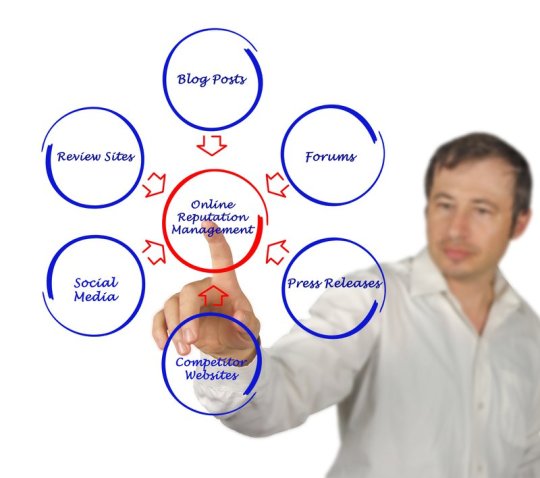
Online Reputation Management
The Pillars of Online Reputation
In the last article, we spoke about online reviews which are just one pillar of building your online reputation. The diagram above mentions several other pillars which are used by your audience to make judgements about your business. They will not apply to every business but they could. For instance, there is nothing stopping any business from issuing Press Releases but few do so.
The main purpose of Online Reviews is to encourage other people to become customers. Having a strong online reputation is a very good way to achieve that as it has a wider reach than “word of mouth” recommendations.
It is, therefore, a good idea to draw attention to any reviews that exist, especially good ones. This can be done by placing some of them on your website but they carry much more credibility if they are on trusted 3rd party sites.
Some Review Sites have “widgets” that enable their reviews to be displayed on a website. There are also review aggregators, which can display reviews from multiple sources on a website in a variety of formats. These provide a steady stream of reviews as they are published and do not require you to amend your website content.
Some best practices:
Have a system in place to obtain customer feedback and use the system on all customers if you can.
Train your staff so that there is consistency in the process, use a checklist if necessary.
Use the feedback to ask for Online Reviews on your preferred review sites, especially when the feedback is positive. Please note that “review gating” is against some review site’s terms.
Respond to Online Reviews, positive or negative, as this is seen as social engagement by the search engines. It can also turn a negative experience into a positive for your business
Ensure that reviews are spread across multiple Review Sites rather than concentrated on just one or two, as this carries more weight with the search engines. Your process should make this easy for the customers.
Post the best reviews on social media or your website. This should be done as an image of a review to comply with the terms of most Review Sites.
Other Pillars
The above tips concern online reviews but what about some of the other ways mentioned in the diagram? One of the common tools used by businesses is content marketing via their blog. Try to find customers who are happy to be quoted or even to be the subject of a short video interview, and use that in your blog articles.
It should already be common practice to amplify your blog articles using social media. A common technique is to publish a blog on your website and then use several “snippets” of information from the blog as social media posts. These can then be scheduled to go out to various social profiles and encourage people to click through to your website to read the whole article.
Some companies will take their best reviews or blogs containing reviews and issue a Press Release (PR). PRs are one of the best ways to get high authority backlinks to your website which increases the traffic to your site. Increases in traffic help to spread the word which helps to build your online reputation.
Online Reputation Automated System
If there are concerns about Online Reviews, there are ways to take control. It is possible to have an automated system that
Requests feedback by email or SMS.
Follows up with reminders.
Filters responses based on the quality of the feedback.
Displays all positive feedback and/or public reviews on your website.
Posts images of reviews to social media.
Enables reviews to individual employees or departments.
Provides comprehensive reports to management.
If you would like to try such a system or find out more about it, get in touch.
About MyLocal
We work with your website designer to improve your ability to be found in Google and other search engines. Also, to look good wherever you may appear online. We specialise in local SEO and most of our work is off-site. But there may need to be some on-site work undertaken by your webmaster to complement what we do. If you would be interested in finding out more, please use the Contact Form on our website.
Want to know the benefits and pitfalls of Online Reviews?
if(window.strchfSettings === undefined) window.strchfSettings = {}; window.strchfSettings.stats = {url: "https://mylocal.storychief.io/strong-online-reputation?id=1171394064&type=2",title: "How can I build a strong Online Reputation?",id: "2fa00077-23a5-4f07-b556-c811dc12f64f"}; (function(d, s, id) { var js, sjs = d.getElementsByTagName(s)[0]; if (d.getElementById(id)) {window.strchf.update(); return;} js = d.createElement(s); js.id = id; js.src = "https://d37oebn0w9ir6a.cloudfront.net/scripts/v0/strchf.js"; js.async = true; sjs.parentNode.insertBefore(js, sjs); }(document, 'script', 'storychief-jssdk'))
https://mylocal.org.uk/local-seo/strong-online-reputation/
0 notes
Text
What has changed in Local SEO?
Google regularly changes its algorithm which can affect Local SEO and the rankings of some businesses. Google’s motivation is to improve the experience of the general public rather than to make things difficult for local businesses. A new service has been developed to monitor these changes and can be seen below.

Google Algorithm Changes
Whenever the monitor goes above a certain number and changes from green it an indication of algorithm changes. The service breaks that down by industry so you can see if yours has been affected. Recently the majority of the changes have been in the hospitality sector.
The major local search factors remain unchanged
Relevance. Relevance refers to how well searches are matching with a local listing. Adding complete and detailed business information can help Google better understand your business and match your Google listing to relevant searches from customers.
Distance. Distance is calculated by how far each potential business is from the location terms used in a search. If a customer doesn't specify a location in their search, Google will calculate distance based on what’s known about their location from their device.
Prominence. Prominence refers to how well-known a business is. Some places are more prominent in the offline world, and search results try to reflect this in local ranking. For example, famous landmarks or well-known brands are also likely to be more prominent in local search results.
A relatively recent change is that prominence is also based on information that Google has about a business from across the Internet (like links, articles and directories). Review count and score are also factored into local search ranking – more reviews and positive ratings will improve a business's local ranking. The business’s position in search results is also a factor, so SEO best practices also apply to local search optimisation.
Google is the New Home Page in Local SEO
Some experts are saying “Google is the new Home Page” for local businesses and this is a definite change. It makes Local SEO even more important than it used to be. What it means is that Google will serve up the entity (local business in this case) that best matches the search query. The entity is displayed in a knowledge panel (on the right-hand side on a large screen device) and provides a summary. The summary includes all the information that Google thinks is relevant.
The net effect of this is that customers no longer need to click through to the website to get the most relevant information. Hence Google is the new Home Page. This also means that Google Analytics does not see these searches as they never reach your site.
Google has also improved its dashboard for business listings with additional features such as Products and Services. The features are dependent on the business category as not all businesses have Products for instance. The dashboard remains one of the best tools to help with Local SEO.
Products is a big change as it is related to other Google products such as Google Merchant Center and surfaces across Google. In summary, if you are a store then Google provides an e-commerce platform for you which can be integrated with Google My Business. Even if you are not using e-commerce, you can use the products section in your dashboard if it exists for your category.
The move to Mobile in Local SEO
Another change is the drift towards mobile devices. Google My Business dashboard is available as an App on smartphones and has some unique features such as messaging. Study after study has shown that searches, particularly local searches, are happening more and more on mobile devices. Considering that Google takes the user’s location into consideration, it is not surprising that they would begin to give users on the go the edge in the searches. Today, in order to make the most of Google and its page ranking algorithm, business owners must ensure their websites are mobile-friendly.
A related change is “voice search” which is becoming mainstream with tools like Siri and Alexa. It is likely that further adjustments to websites will have to be made to make them more “voice friendly”.
Facebook has become a Local Search engine and e-commerce platform in its own right. It is quite possible these days for both businesses and consumers to live exclusively in the Facebook world to do business. Facebook owns Instagram and it is possible to set up a Store on either platform which is similar to using Google Merchant Center. It is not a recommended business strategy but it just shows how far Facebook has come. Both Facebook and Google are targeting the success of Amazon and eBay with their merchant offerings.
About MyLocal
We work with your website designer to improve your ability to be found in Google and other search engines. Also, to look good wherever you may appear online. We specialise in local SEO and most of our work is off-site. But there may need to be some on-site work undertaken by your webmaster to complement what we do. If you would be interested in finding out more, please use the Contact Form on our website.
Do you know what Local SEO typically costs?
if(window.strchfSettings === undefined) window.strchfSettings = {}; window.strchfSettings.stats = {url: "https://mylocal.storychief.io/local-seo-changes?id=1135357682&type=2",title: "What has changed in Local SEO?",id: "2fa00077-23a5-4f07-b556-c811dc12f64f"}; (function(d, s, id) { var js, sjs = d.getElementsByTagName(s)[0]; if (d.getElementById(id)) {window.strchf.update(); return;} js = d.createElement(s); js.id = id; js.src = "https://d37oebn0w9ir6a.cloudfront.net/scripts/v0/strchf.js"; js.async = true; sjs.parentNode.insertBefore(js, sjs); }(document, 'script', 'storychief-jssdk'))
https://www.mylocal.org.uk/local-seo/local-seo-changes/
0 notes
Text
How much do Local SEO services cost?
As the landscape is constantly changing I performed a Google search to try to find “Local SEO services cost”. For packaged services, the answer that came back was between $199 and $499 per month. A reputable Canadian based company called Whitespark was $349/m and listed their services as

Local SEO services cost from Whitespark
Other well-known companies specialise in providing specific services such as Citation Management. An example of this is Yext which offers a range of plans costing typically about £30 per month. Our view is that the hard work with citations is getting them established and that is worth paying for. After that, they only need to be monitored and that should not cost as much as most companies charge.
Local SEO Set-up versus On-going costs
The majority of Local SEO work only has to be undertaken once, like establishing citations. For instance, once a Google My Business listing is set up and optimised, that job is effectively done and the next one can be undertaken. Comparing that with SEO work, which involves constant ongoing tasks, explains why Local SEO is less expensive than Organic SEO.
Local businesses should, therefore, seek to divide the cost into “set-up” versus “on-going” work. It will be less expensive over the long term if the on-going costs can be reduced as much as possible.
The set-up cost will obviously depend on what needs to be done, and that cannot be determined without an audit. Most suppliers will undertake an audit so that they can provide a quotation, so getting a few quotes is not a bad tactic.
This blog series has listed the main things that need to be done so that business owners can compare quotations in an informed manner. Once the set-up is complete then it is possible to see how you compare with your main competitors. Only then can you decide what level of on-going services you need. If you are ranking number 1 for your main keywords already then you can go with minimal on-going services. If you are not ranking at all then you may need more extensive on-going services.
Local SEO services cost – ask your consultant
There are a number of companies that offer services in this area but great care must be taken in choosing the right one for the job. Some definitely get results but others do not and that is very difficult for the layman to know. That is why working with a Local SEO consultant can be money well spent.
These professionals know everything there is to know about Local SEO, and they can get the business’s name in places – and in front of customers – the business owner will not know about or may have never thought of.
Moreover, because there are so many changes taking place, a good Local SEO consultant will keep on top of the latest developments. A retained Local SEO consultant will monitor the clients’ businesses and make adjustments when required in reaction to these changes.
Where changes to a website are required then it makes sense for your webmaster to make those changes. However, knowing what changes to make should come from a Local SEO expert rather than your webmaster. If changes are required then it indicates that your webmaster did not realise, otherwise the changes would not have been required.
In summary, divide the cost into set-up and on-going. First, get set up and then look to see how you compare with your competitors. Only then decide on your on-going monthly services. Typically the monthly costs range between $199 and $499 for the full range of services available.
About MyLocal
We work with your website designer to improve your ability to be found in Google and other search engines. Also, to look good wherever you may appear online. We specialise in local SEO and most of our work is off-site. But there may need to be some on-site work undertaken by your webmaster to complement what we do. If you would be interested in finding out more, please use the Contact Form on our website.
Want to know how to measure the success of Local SEO?
if(window.strchfSettings === undefined) window.strchfSettings = {}; window.strchfSettings.stats = {url: "https://mylocal.storychief.io/local-seo-services-cost?id=173402024&type=2",title: "How much do Local SEO services cost?",id: "2fa00077-23a5-4f07-b556-c811dc12f64f"}; (function(d, s, id) { var js, sjs = d.getElementsByTagName(s)[0]; if (d.getElementById(id)) {window.strchf.update(); return;} js = d.createElement(s); js.id = id; js.src = "https://d37oebn0w9ir6a.cloudfront.net/scripts/v0/strchf.js"; js.async = true; sjs.parentNode.insertBefore(js, sjs); }(document, 'script', 'storychief-jssdk'))
https://www.mylocal.org.uk/local-seo/local-seo-services-cost/
0 notes
Text
How can I measure success?
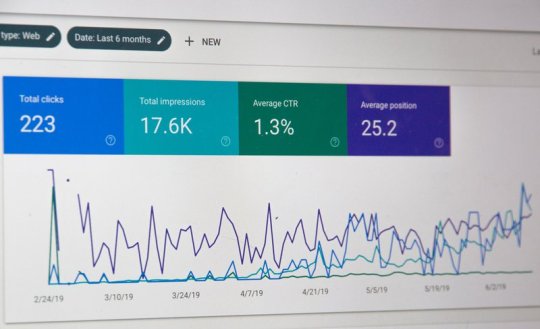
Photographer: Webaroo | Source: Unsplash | How to measure success
It is wise to establish how you are going to measure success before spending money on any marketing campaign. This applies whether it is TV, postal mailshot, email marketing, online advertising, social media marketing, or SEO. This series focuses on Local SEO so we will look at the metrics that could be measured.
Measure Success using Google My Business Insights
The metrics in Google My Business Insights include
Number of Google Searches
Number of Google Map Searches
Direct v Discovery Searches
Number of click-throughs to your website
Number of Direction requests
Number of Phone calls
Number of Photo views
Queries used to find your business
The Insights that are provided as part of Google My Business are not terribly accurate and should not be taken too literally. They are, however, reasonable at seeing trends and whether there has been an improvement over time. In the absence of anything better, they should be studied regularly such as once a month to measure success.
One issue with GMB Insights is that you only get up to 90 days of data in the dashboard. However, you can get more data via Google’s API. This means that some 3rd party tools can provide years of data which can be very useful for trends and comparisons. Some of these tools provide much more interesting insights but there are too many of them to deal with here. Please note that Google’s tools are generally free whereas 3rd party tools are usually charged for.
Brightlocal Monitoring Tools
My clients tend to be monitored using BrightLocal which has a series of reports that add value over time. One shows which businesses rank in positions 1-10 for 5 local keywords so you can see how you compare with your competitors. An advantage of these reports is that you can set the location of the searches. You can also see your competitors’ metrics and work out what you need to do to rank better.
Another 3rd party report from Local Falcon shows your rank for a specific keyword on a geographic grid. This enables you to see if a business only ranks well very close to its location, which it should. The further away from its location, a business ranks the stronger its ranking position is. This is very difficult to test and visualise without such a tool.
There are many other “Analytics” available such as Google Analytics, Google Search Console, and the analytics associated with each social media platform used. There are tools which can pull all of these different data sources together in one report which is perhaps the best solution. The most important thing is to actually look at the data on a regular basis even if only monthly.
Measure Success with Google Analytics
Google Analytics is perhaps the best-known free tool but it is also one of the least exploited. It will only work if you installed on a website and if it has been set up to monitor the right things. For instance, it is capable of measuring “Conversions” provided that goals have been set. I do not know the statistics but I would venture a guess that less than 10% of businesses that use Google Analytics actually set their goals within the system. That would mean that 90% of Google Analytics installations would not measure success.
Google Analytics only looks at “on page” activity (i.e. activity on a website). If a business is well set up for Local Search then most people won’t need to click through to the website to get what they want, such as a telephone number, hours of operation or driving directions. So a lot of the success of local SEO will never be picked up by Google Analytics, hence the need for other measures.
One thing that should be monitored in Google Analytics is “Bounce Rate” which is people leaving a website quickly for whatever reason. The reason needs to be investigated because it may be preventing the business from achieving its goals. Imagine having a high bounce rate and not knowing for days, weeks or months, which would be quite possible in the absence of regular monitoring.
Google Analytics also enables a high degree of segmentation based on things like how long people stayed on-site, which pages they visited etc. It is this aspect that is so rarely taken advantage of even though it is completely free to do so.
Take a hotel with a restaurant and a spa. It would make sense to have pages on its website dedicated to each part of its business. However, if the customer journeys are not being tracked by Google Analytics, there will be no information on them. The hotel will not know which visitors to its website were interested in which service it was offering. It will miss out on the opportunity to market to people who have indicated what they are interested in.
We are getting into territory that goes beyond the scope of local SEO, but the point is that it is important to measure. To summarise
In order to measure success, goals have to be established in the first place.
Measuring systems need to be in place to measure those goals.
The reports need to be studied on a regular basis.
Action needs to be taken based on the observations.
if(window.strchfSettings === undefined) window.strchfSettings = {}; window.strchfSettings.stats = {url: "https://mylocal.storychief.io/how-to-measure-success?id=607483366&type=2",title: "How can I measure success?",id: "2fa00077-23a5-4f07-b556-c811dc12f64f"}; (function(d, s, id) { var js, sjs = d.getElementsByTagName(s)[0]; if (d.getElementById(id)) {window.strchf.update(); return;} js = d.createElement(s); js.id = id; js.src = "https://d37oebn0w9ir6a.cloudfront.net/scripts/v0/strchf.js"; js.async = true; sjs.parentNode.insertBefore(js, sjs); }(document, 'script', 'storychief-jssdk'))
https://www.mylocal.org.uk/local-seo/how-to-measure-success/
0 notes